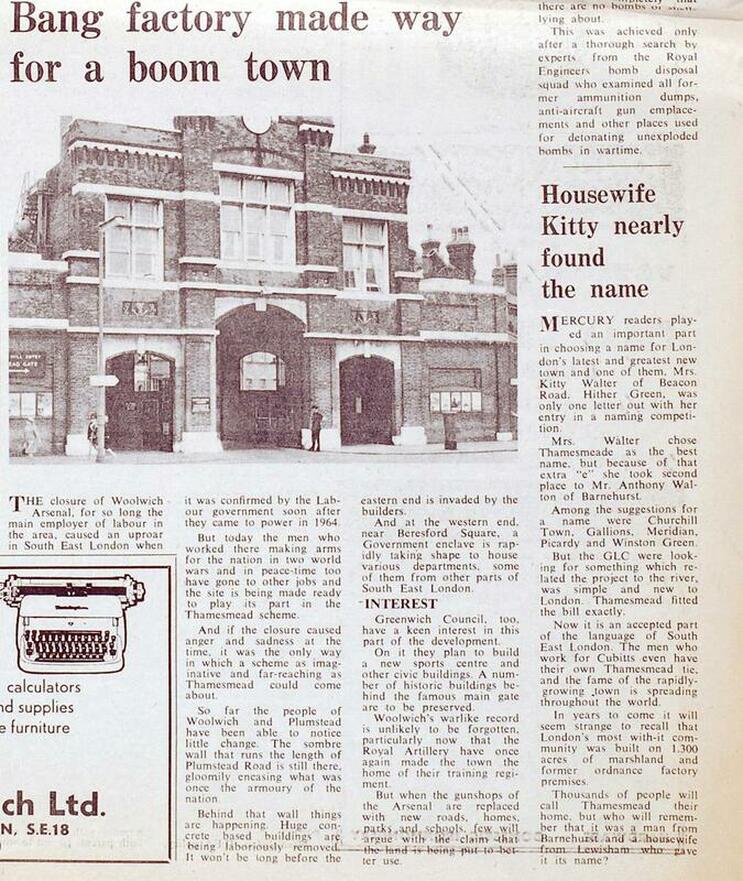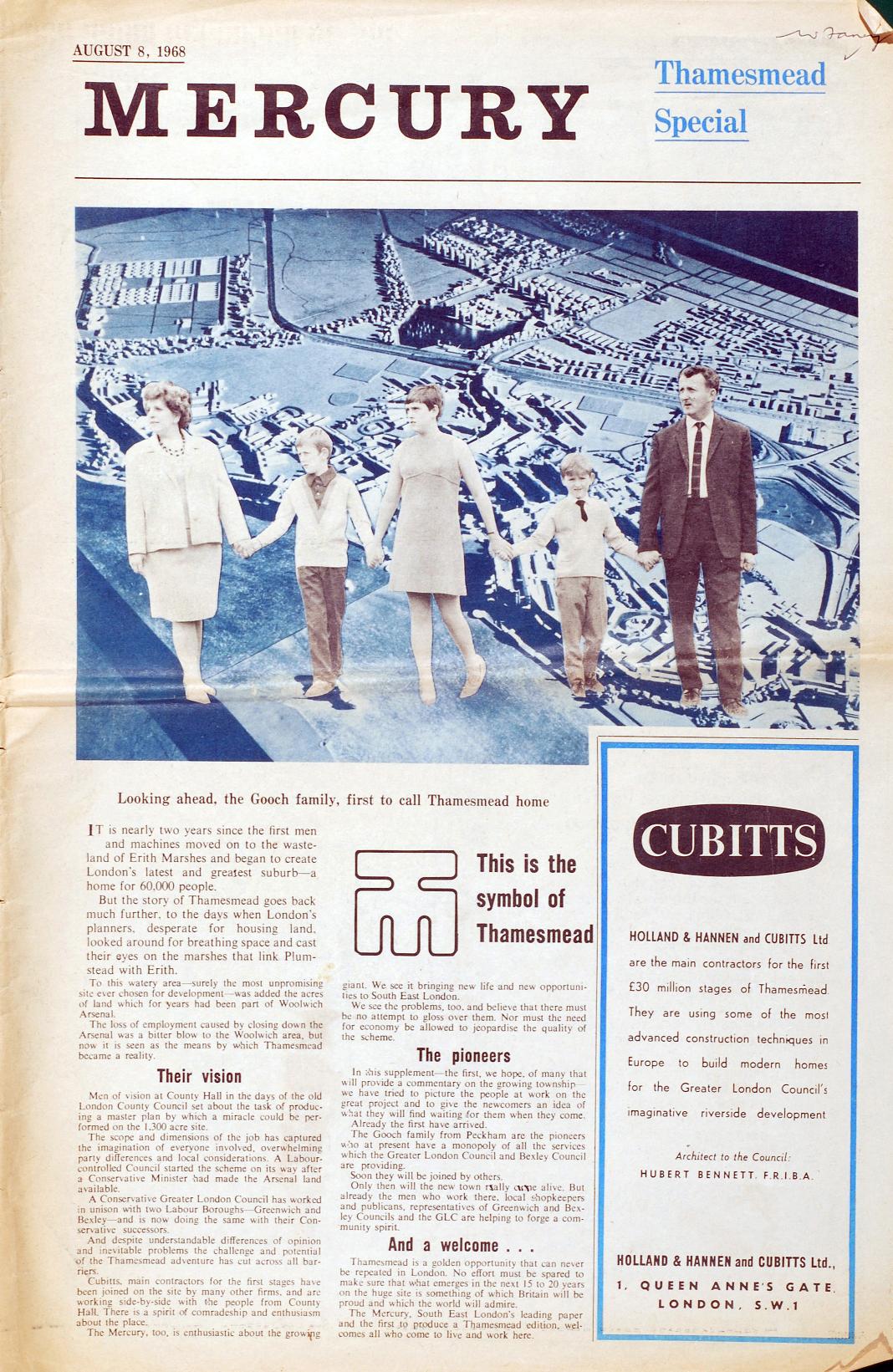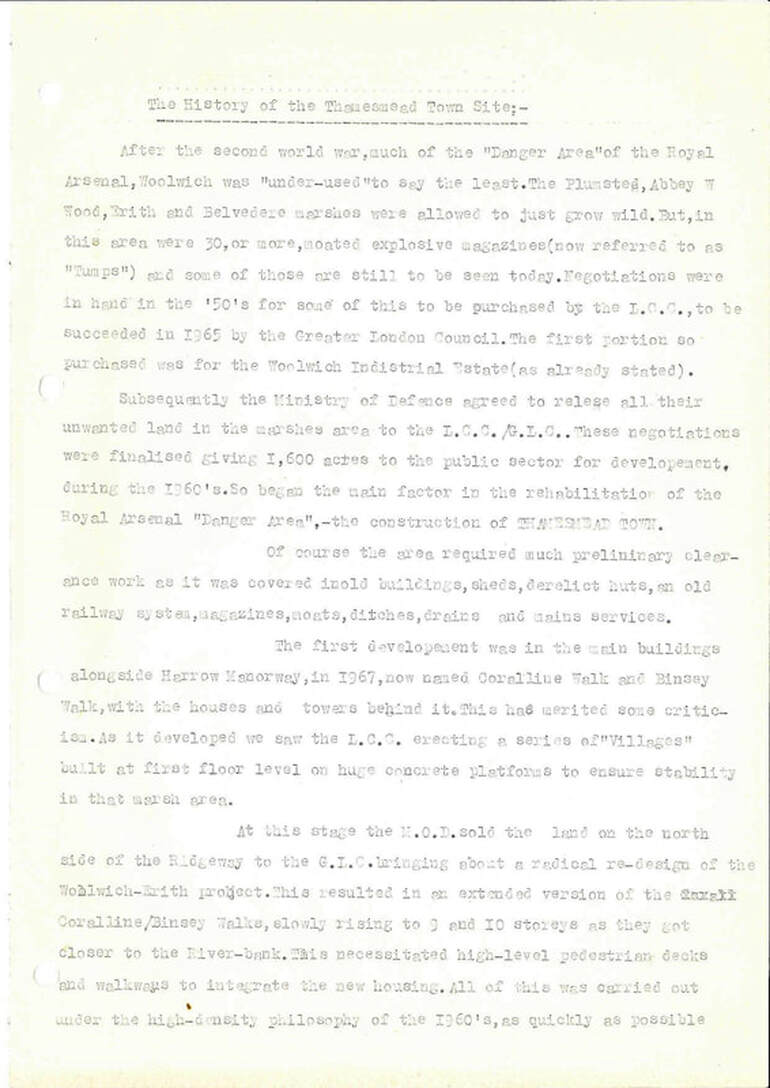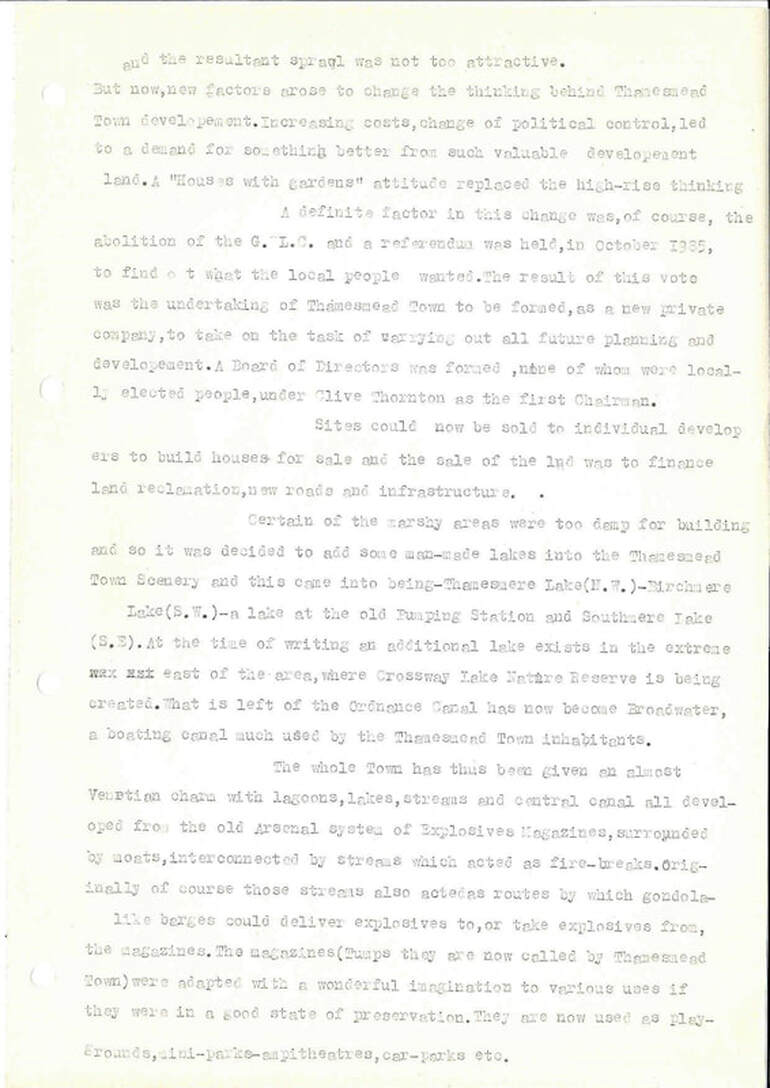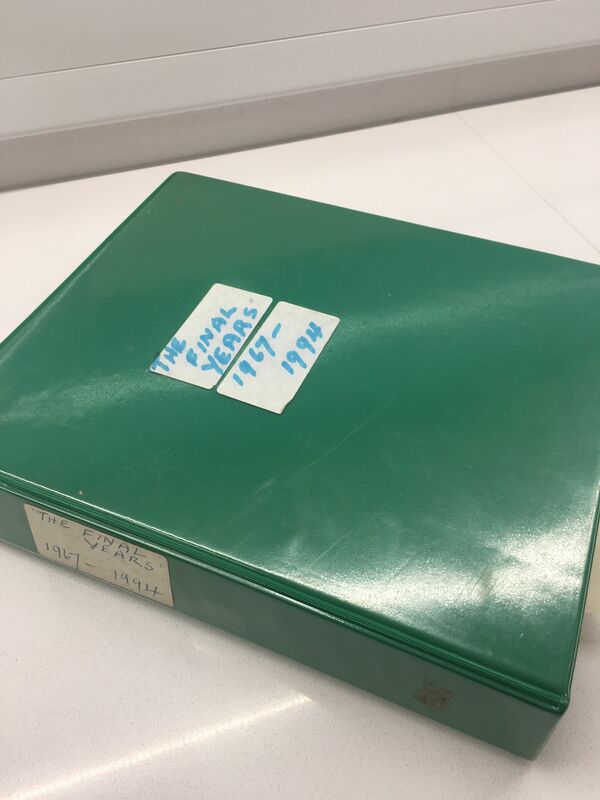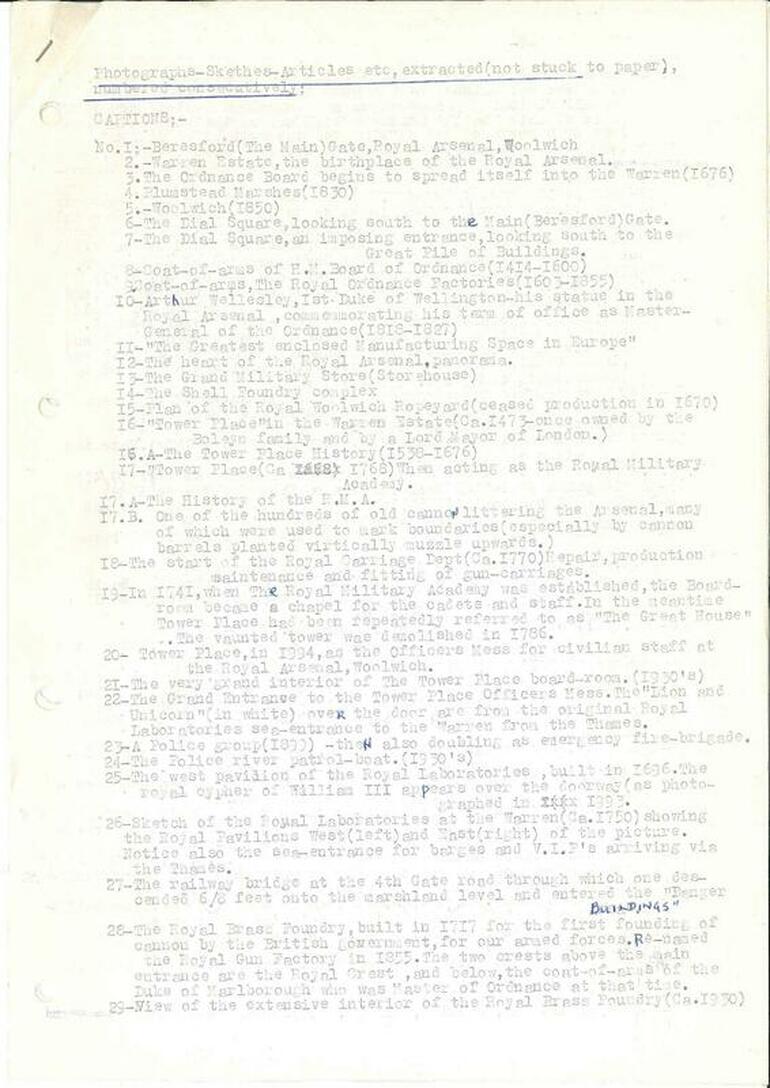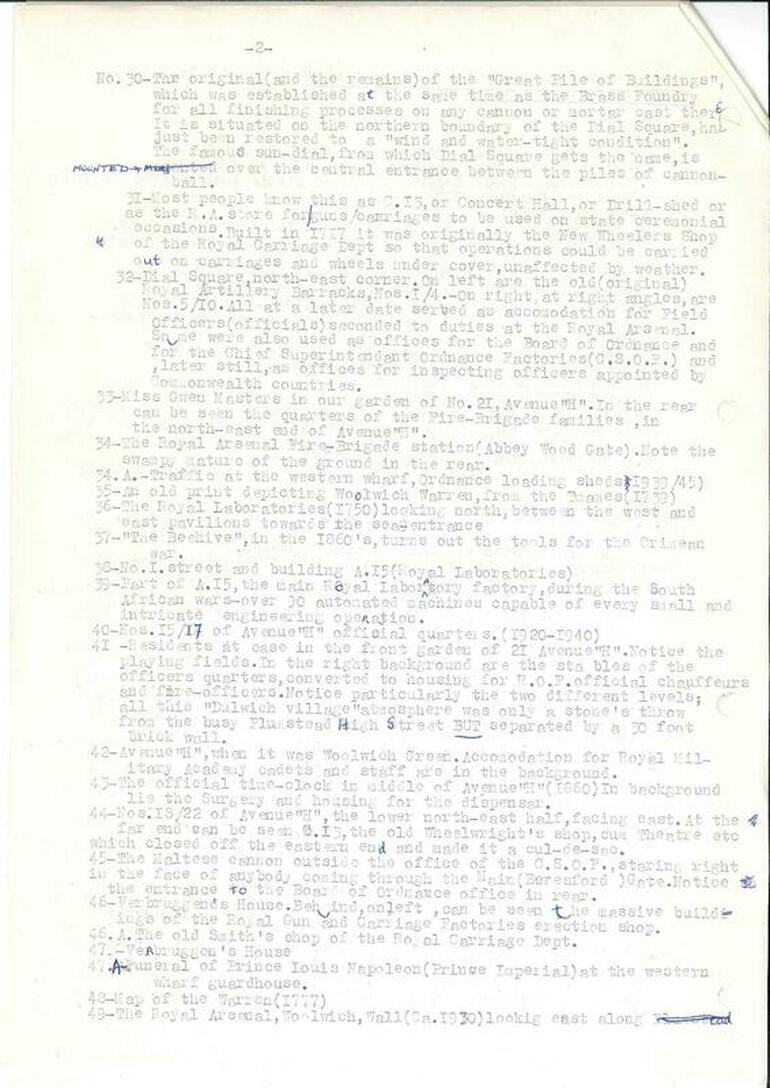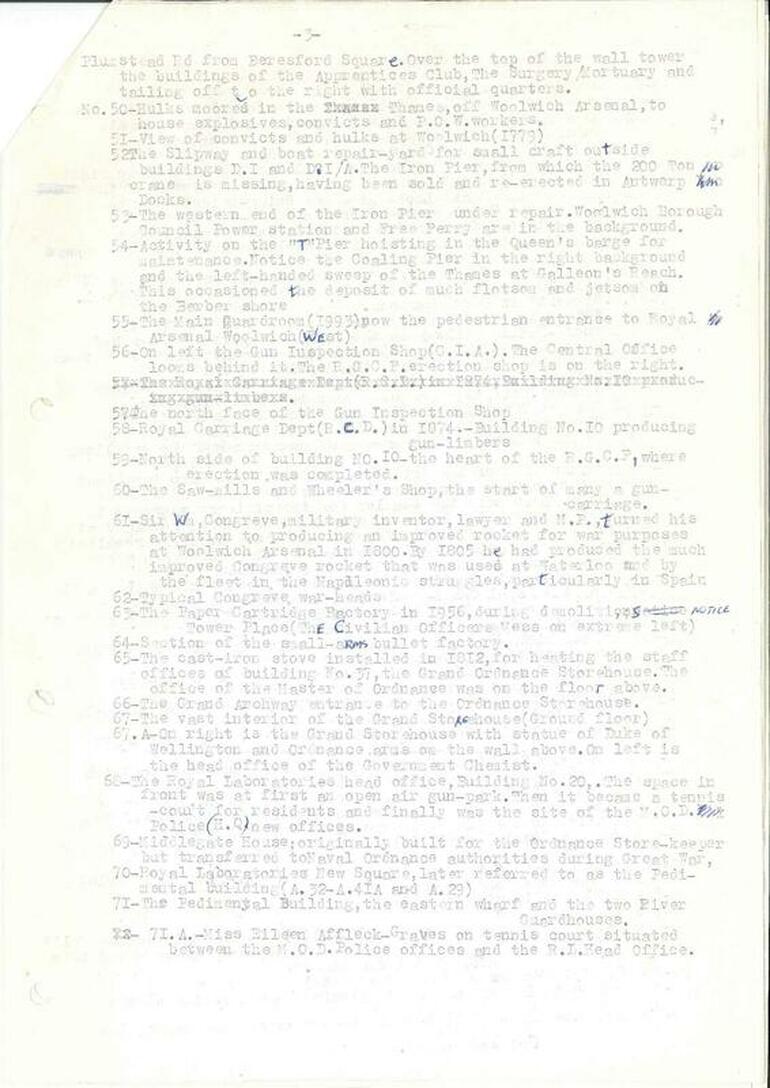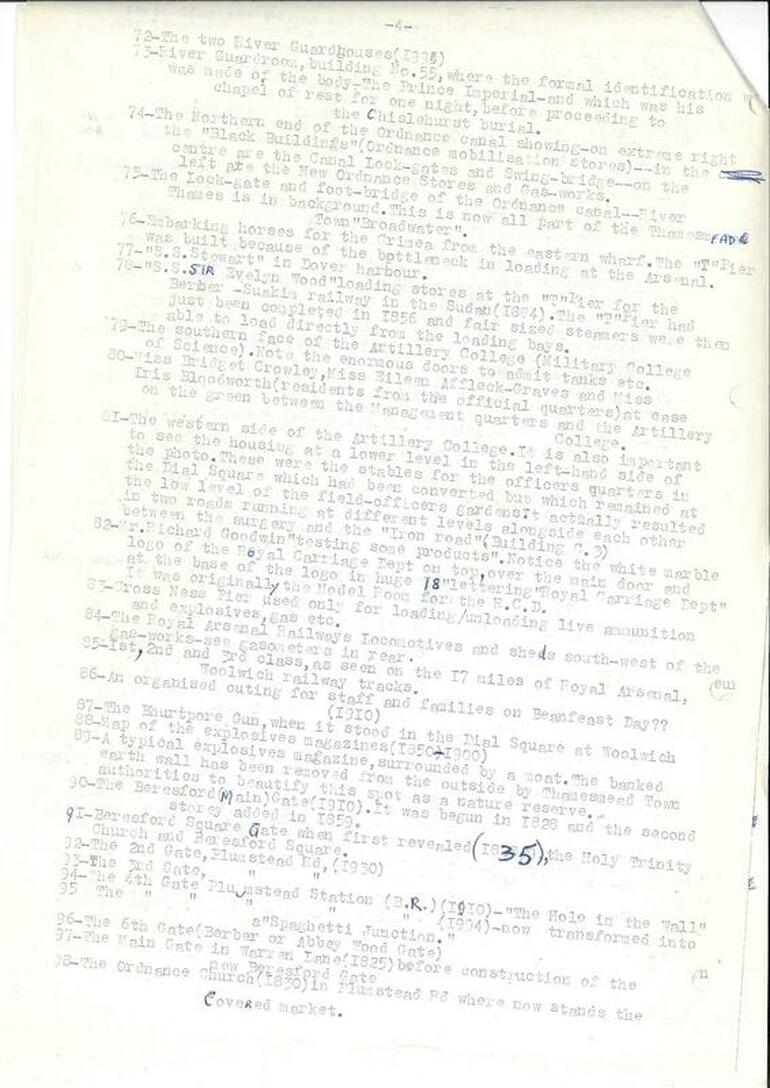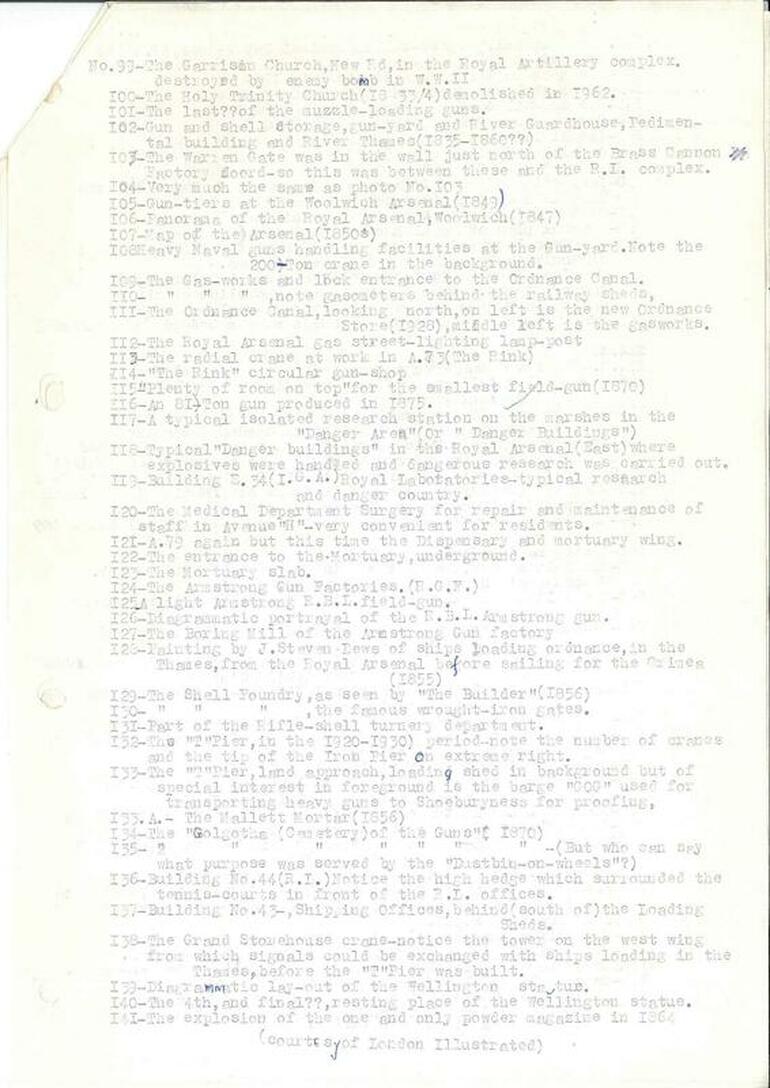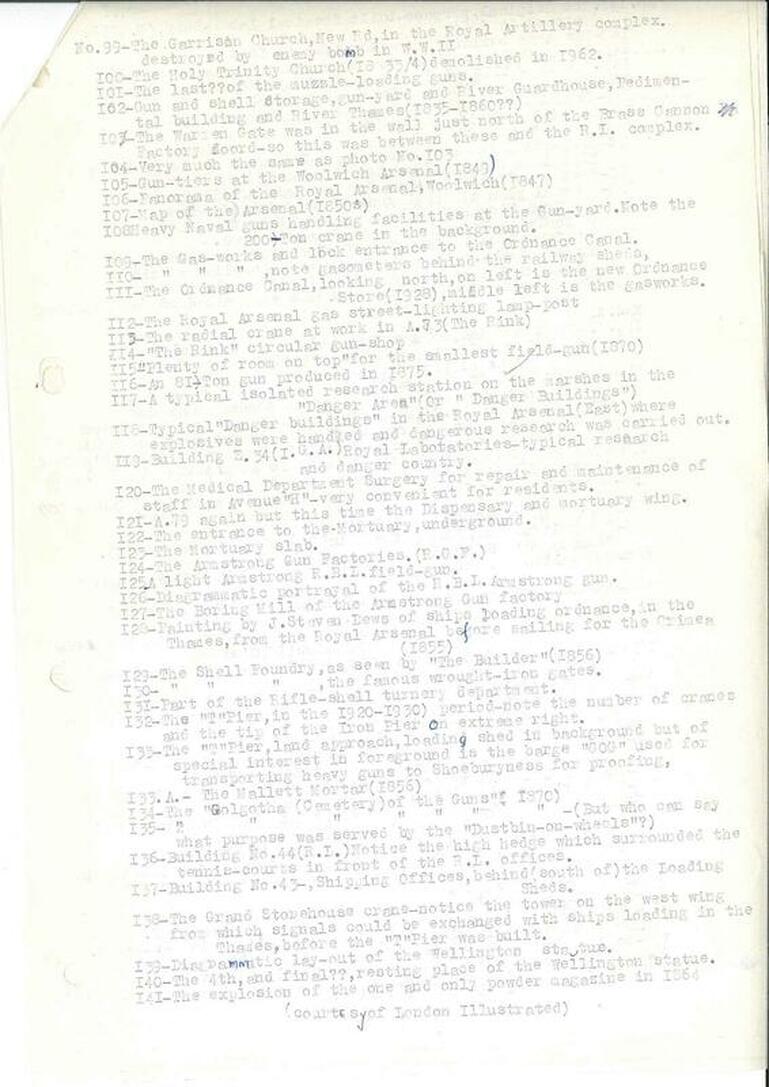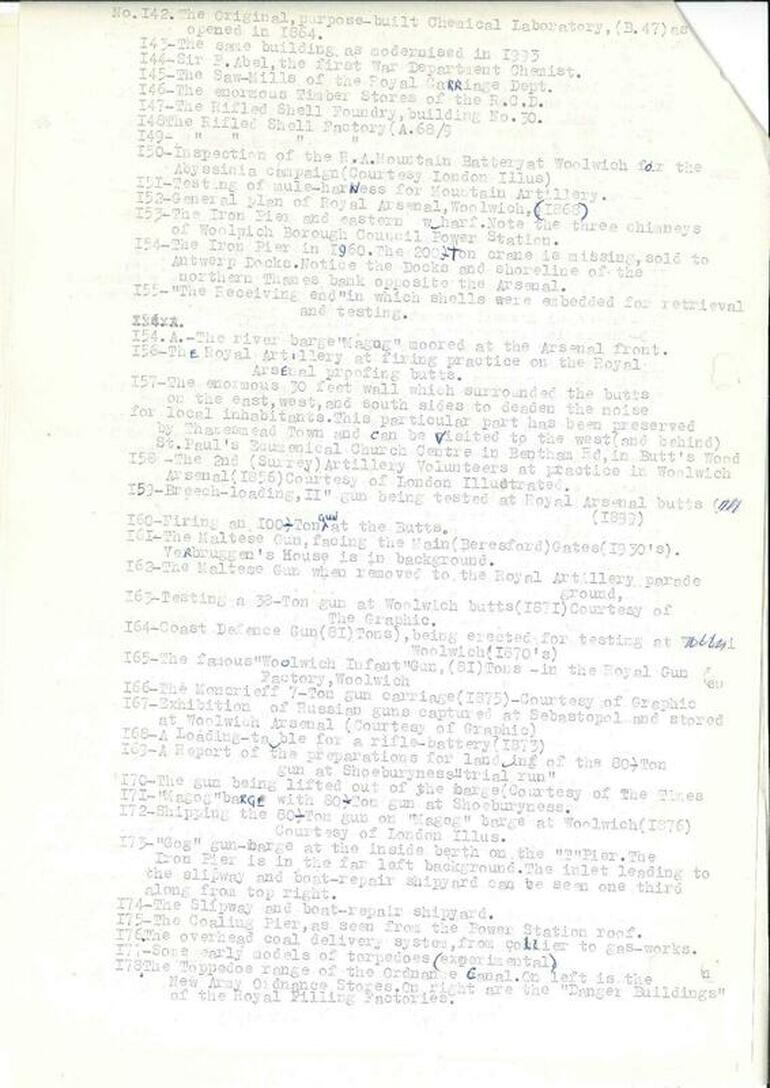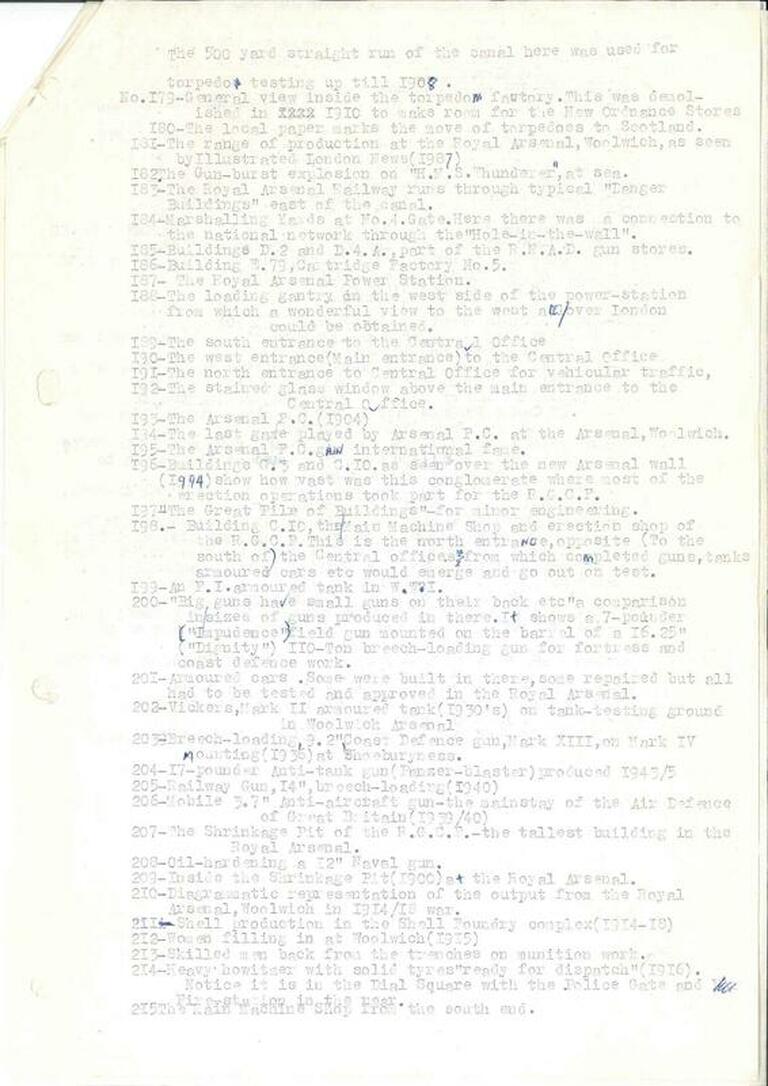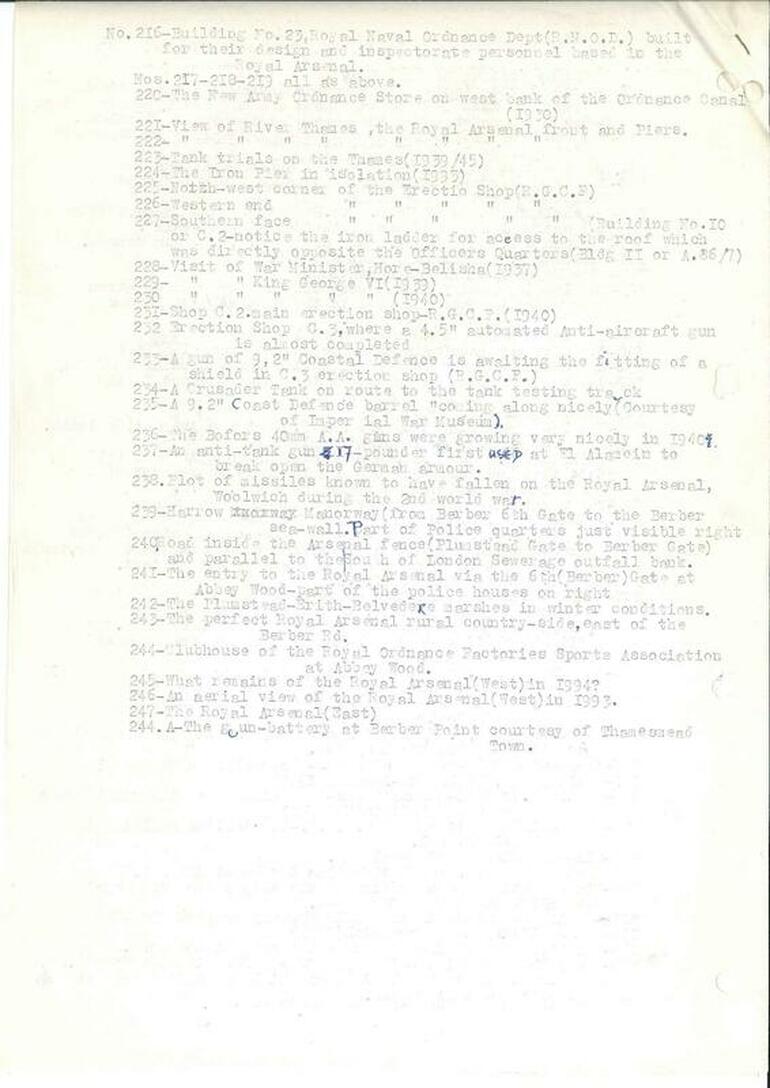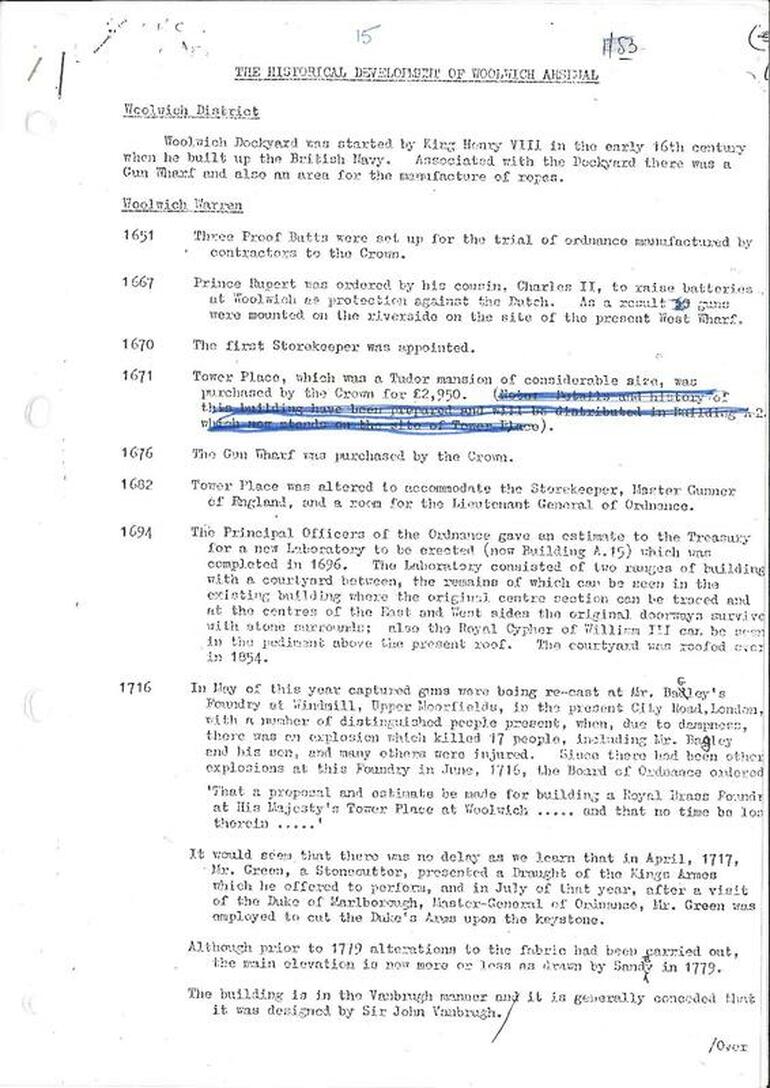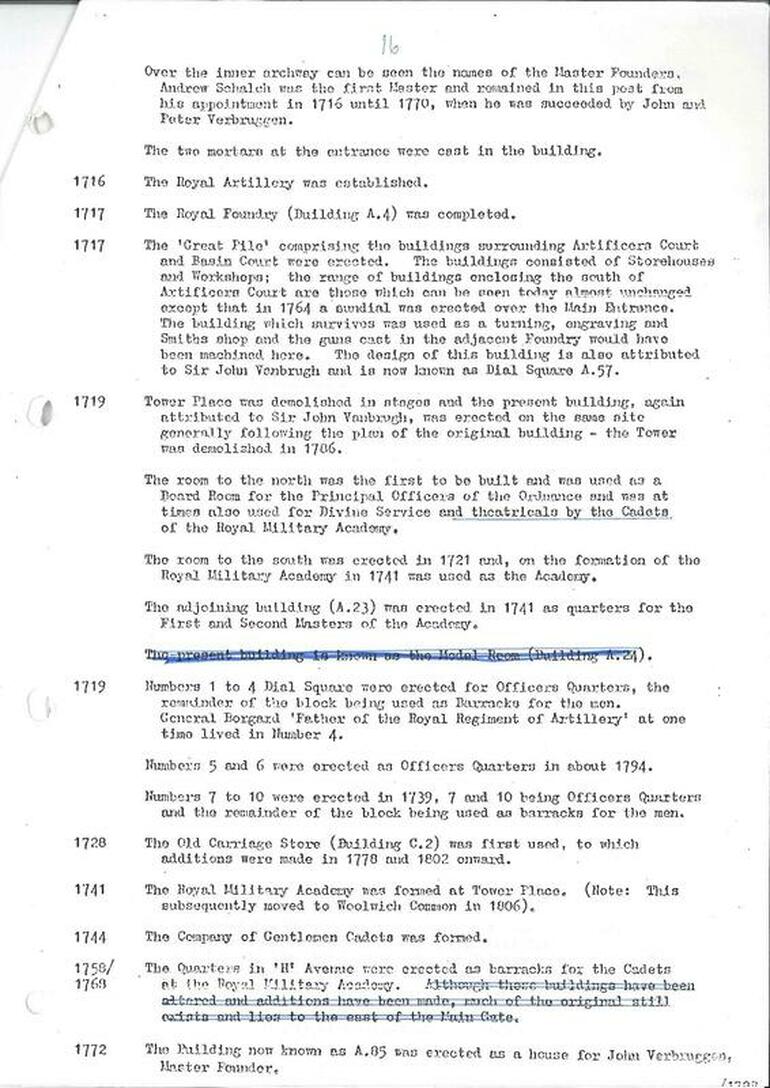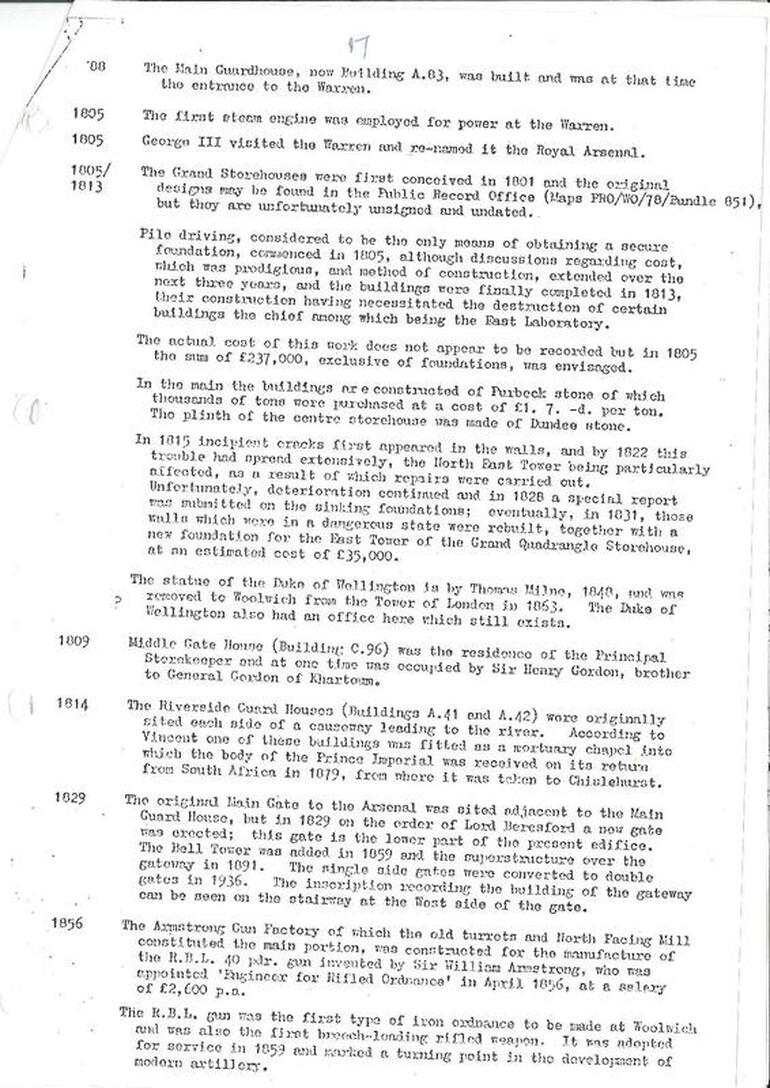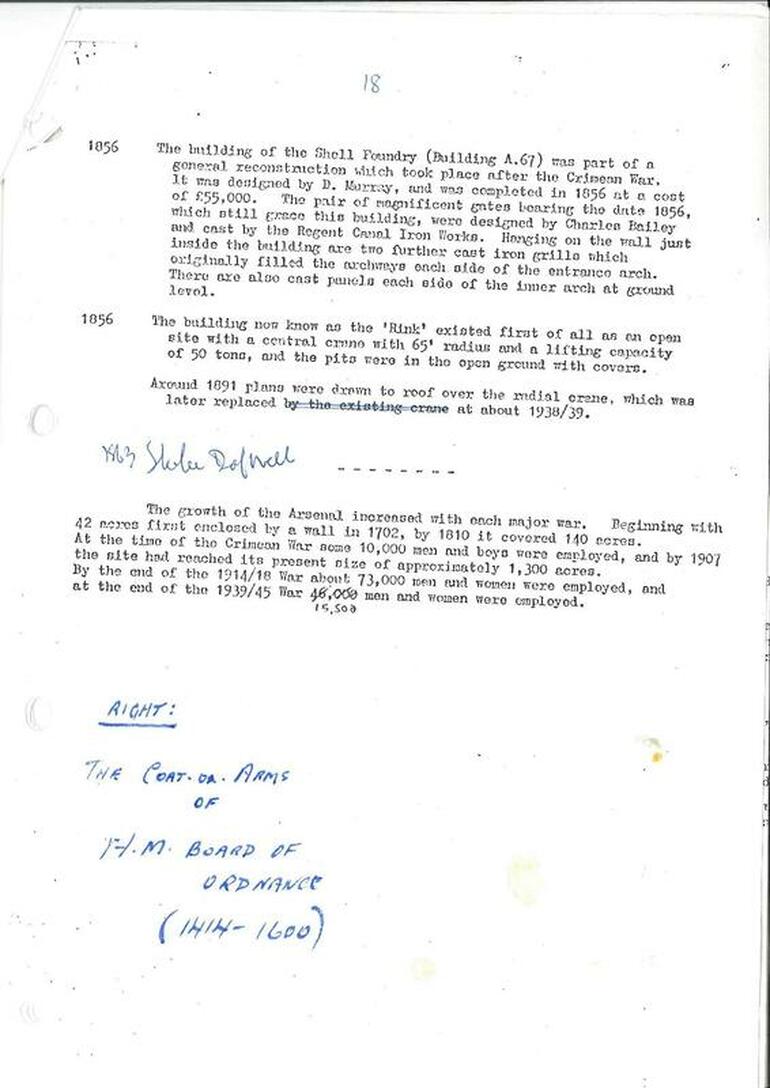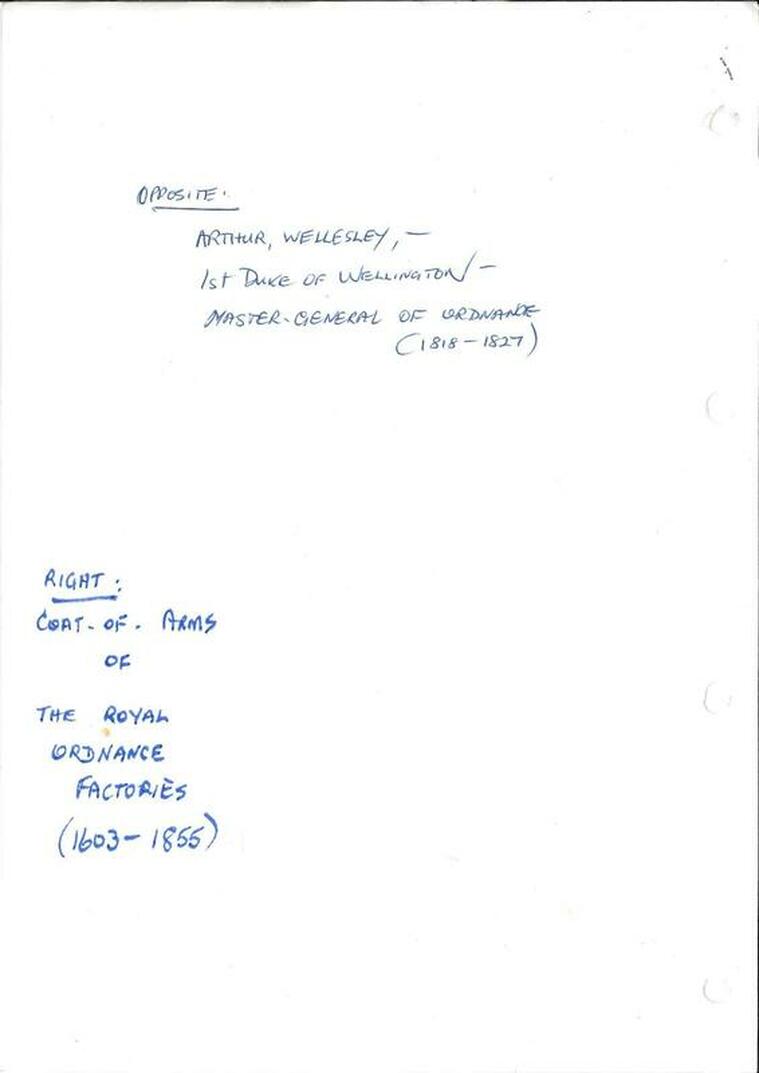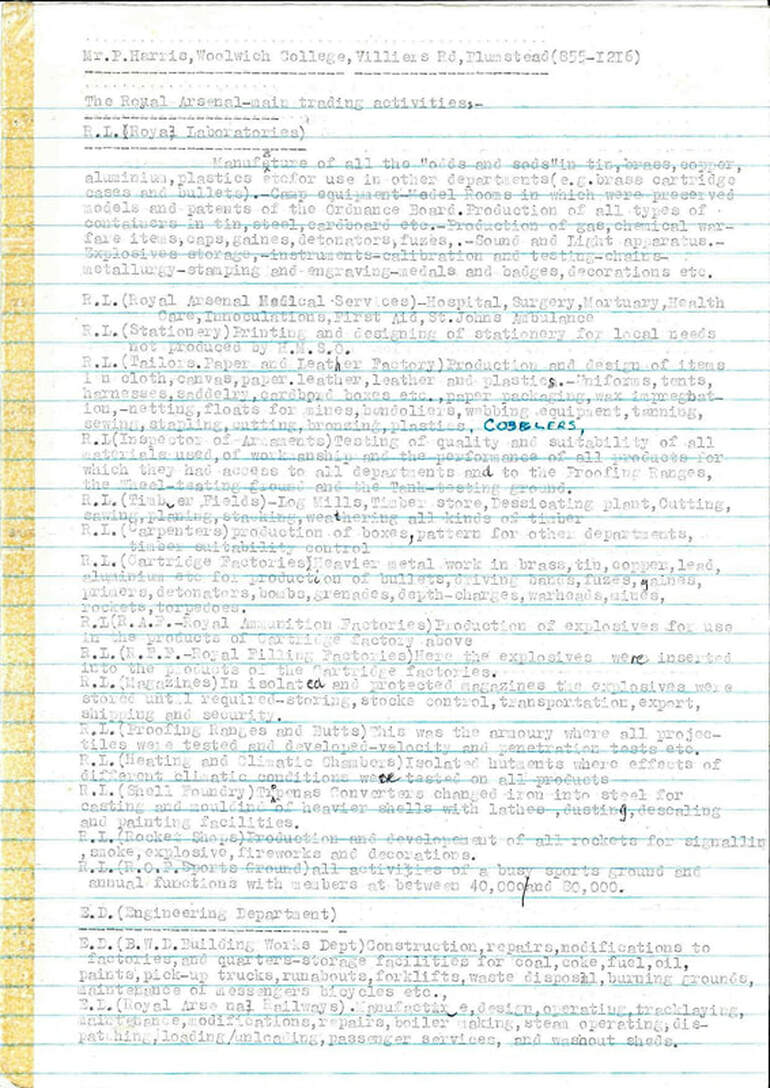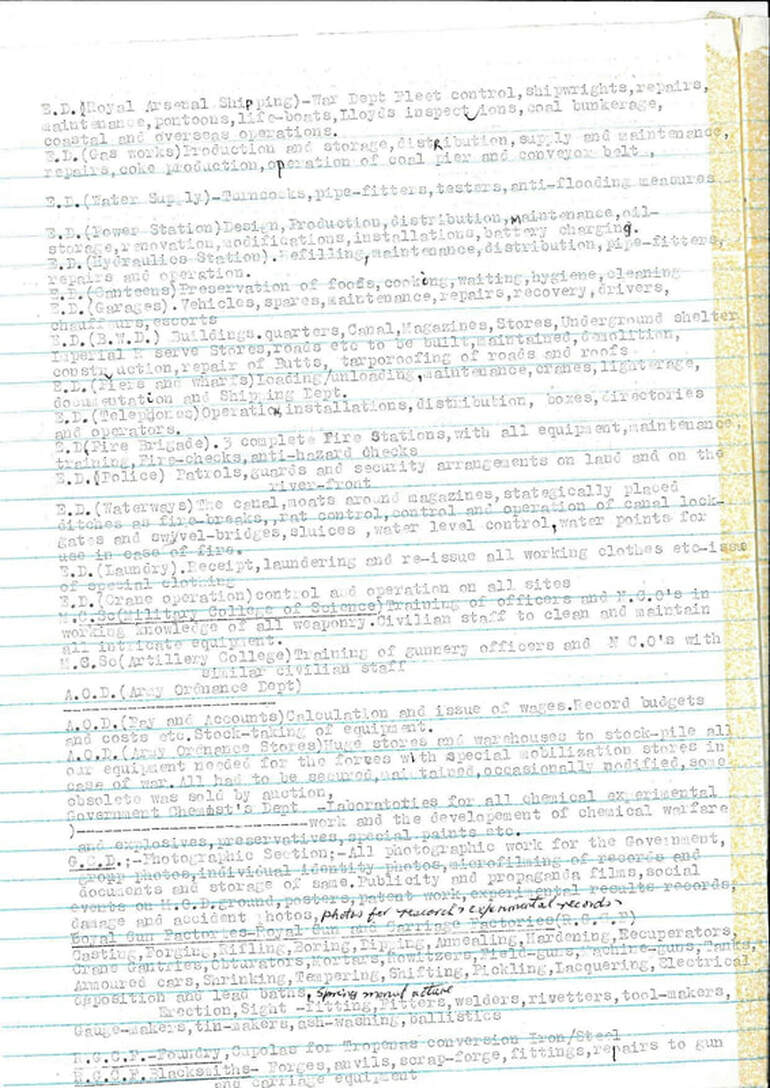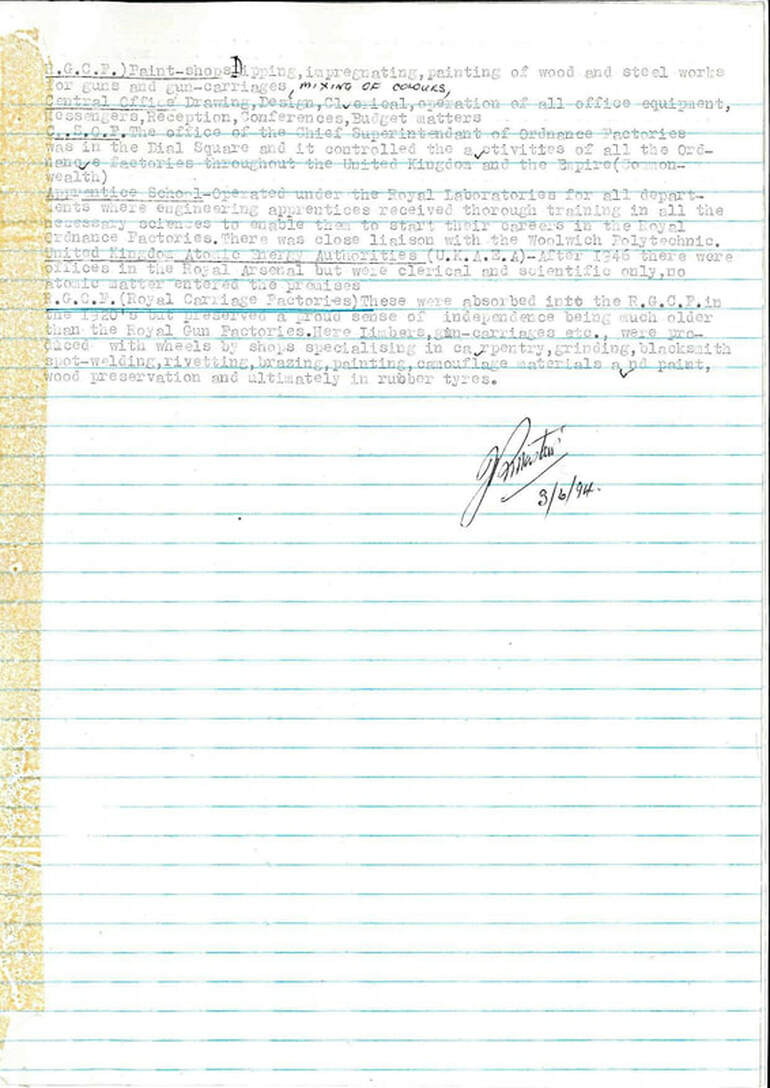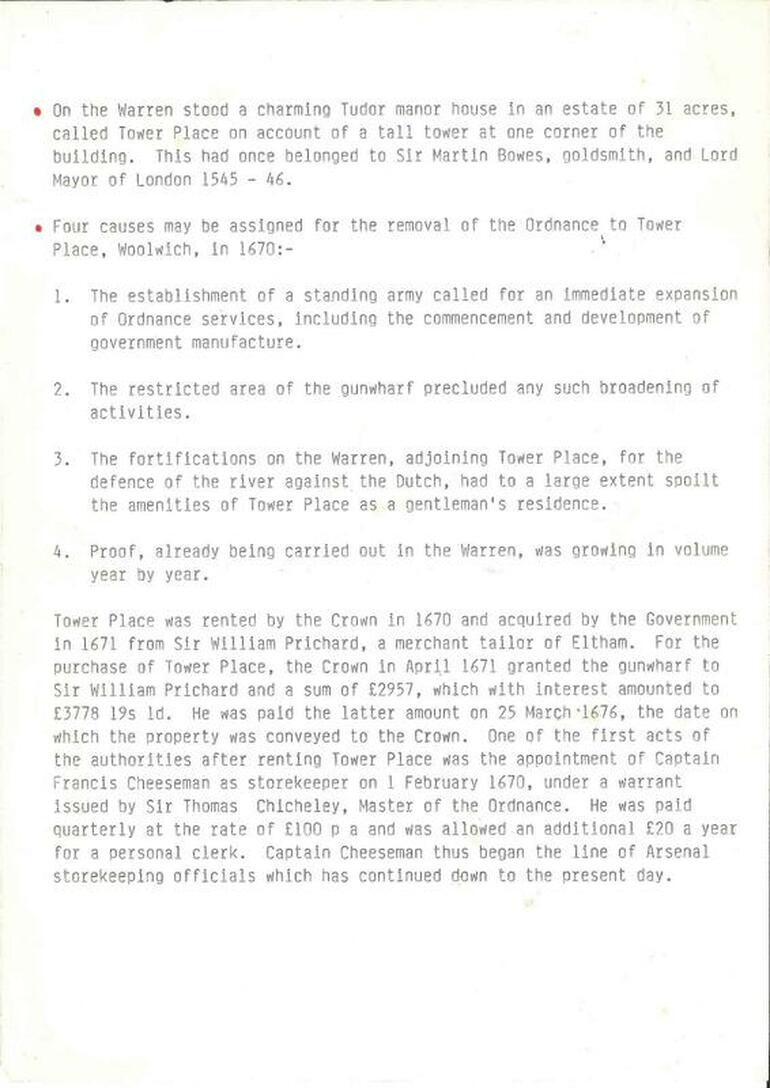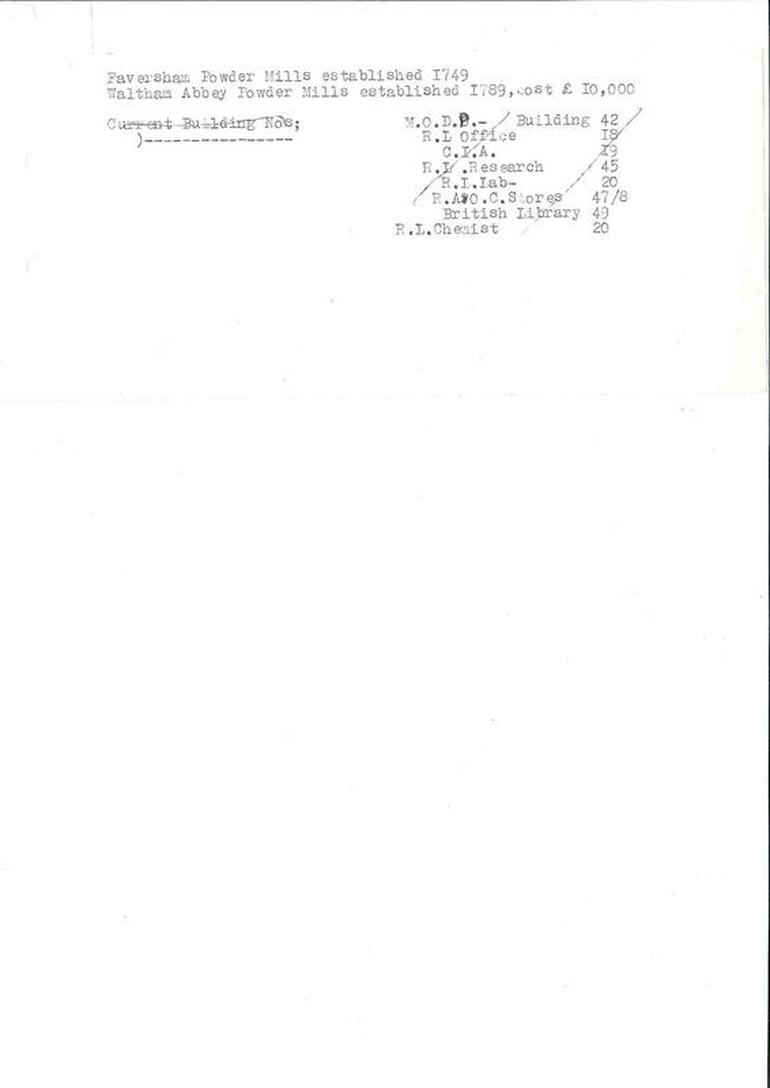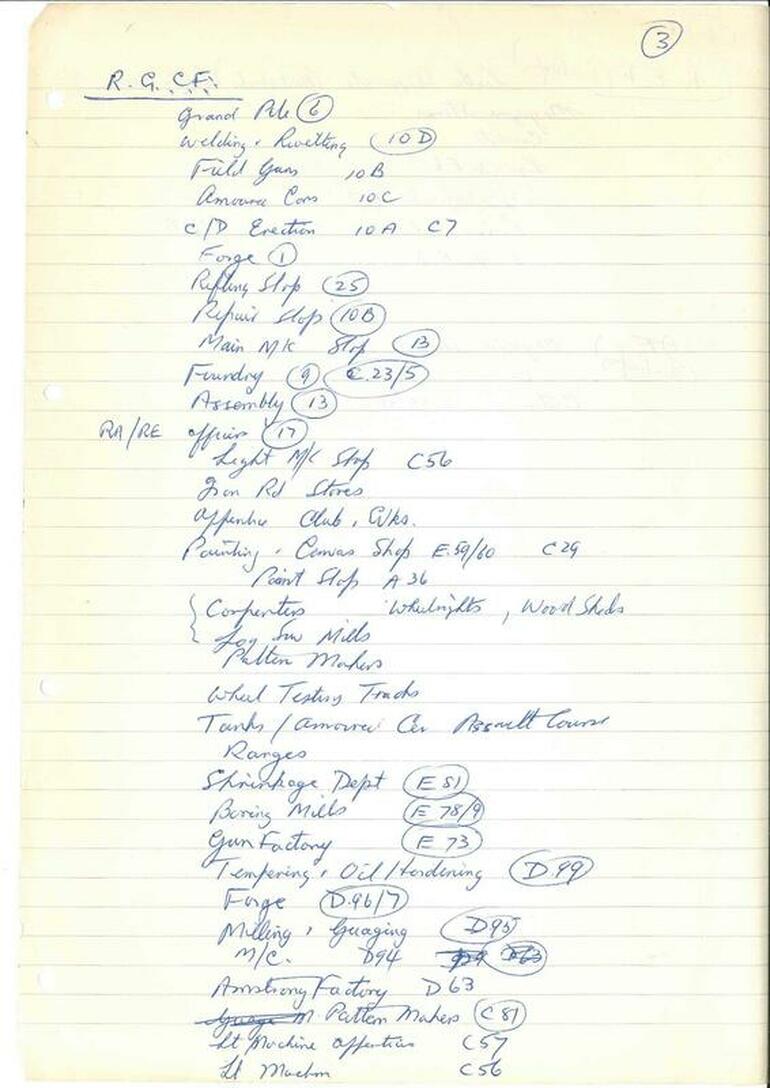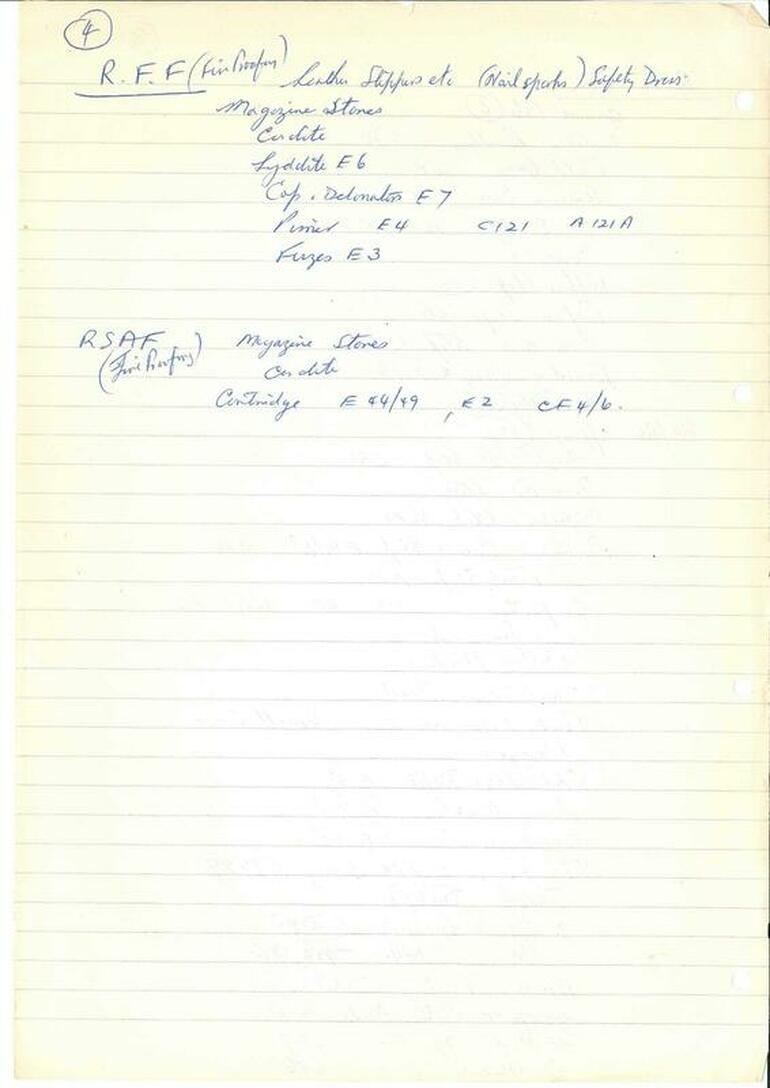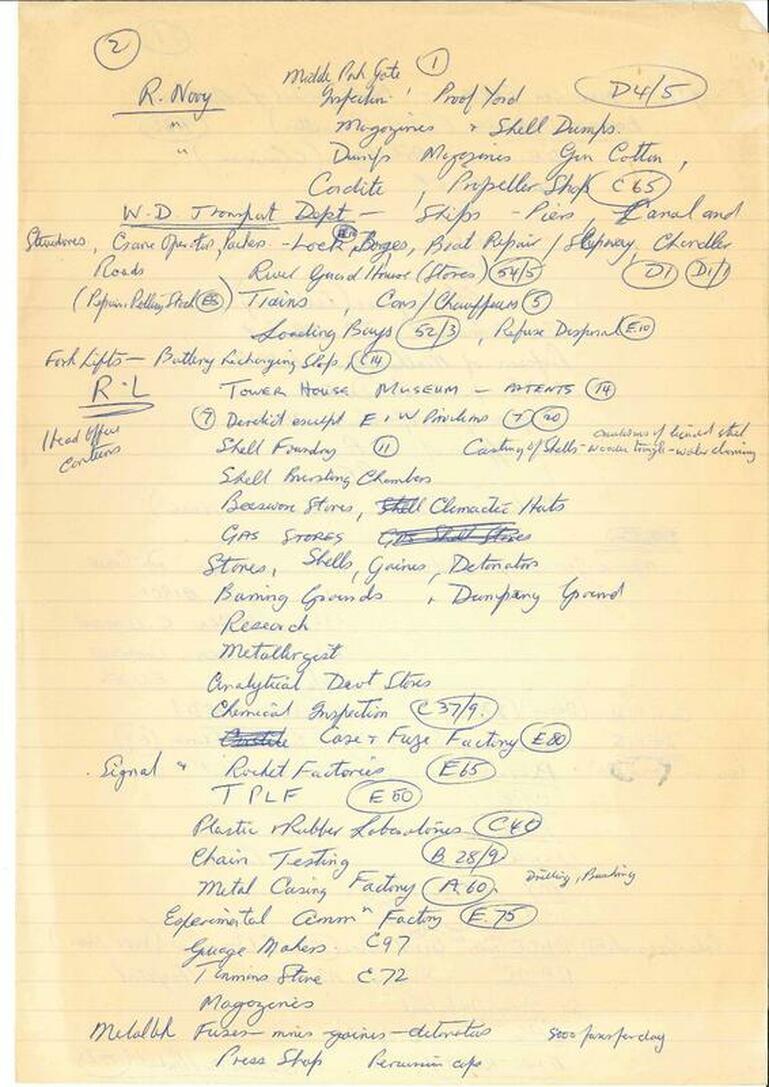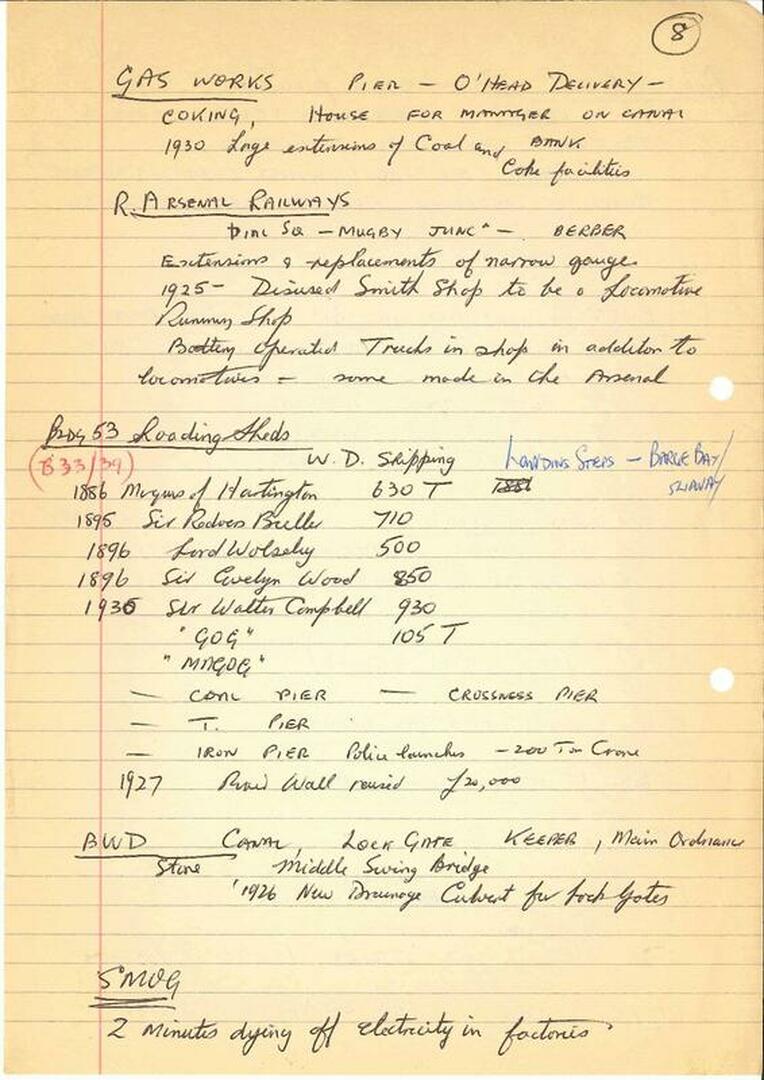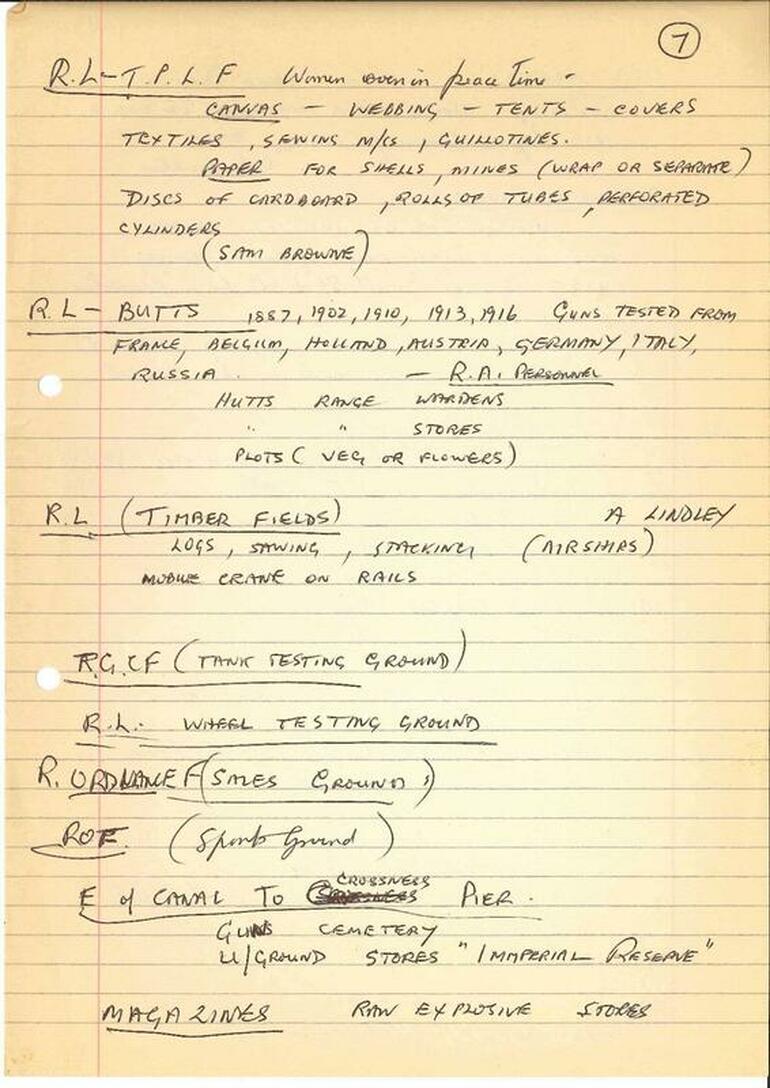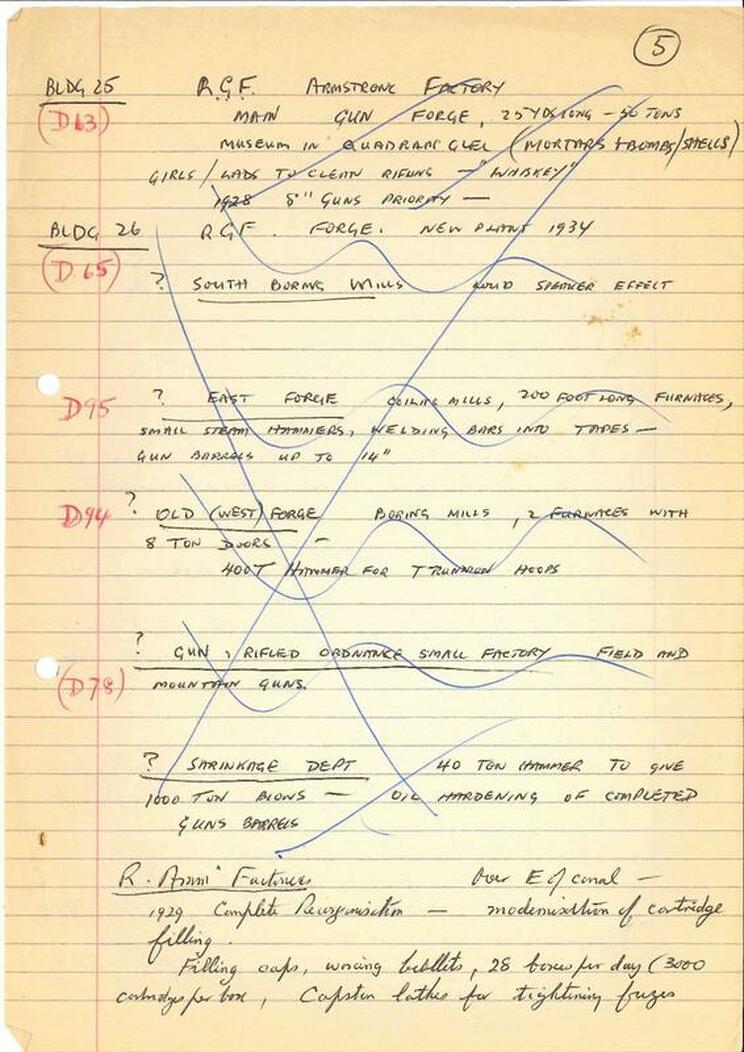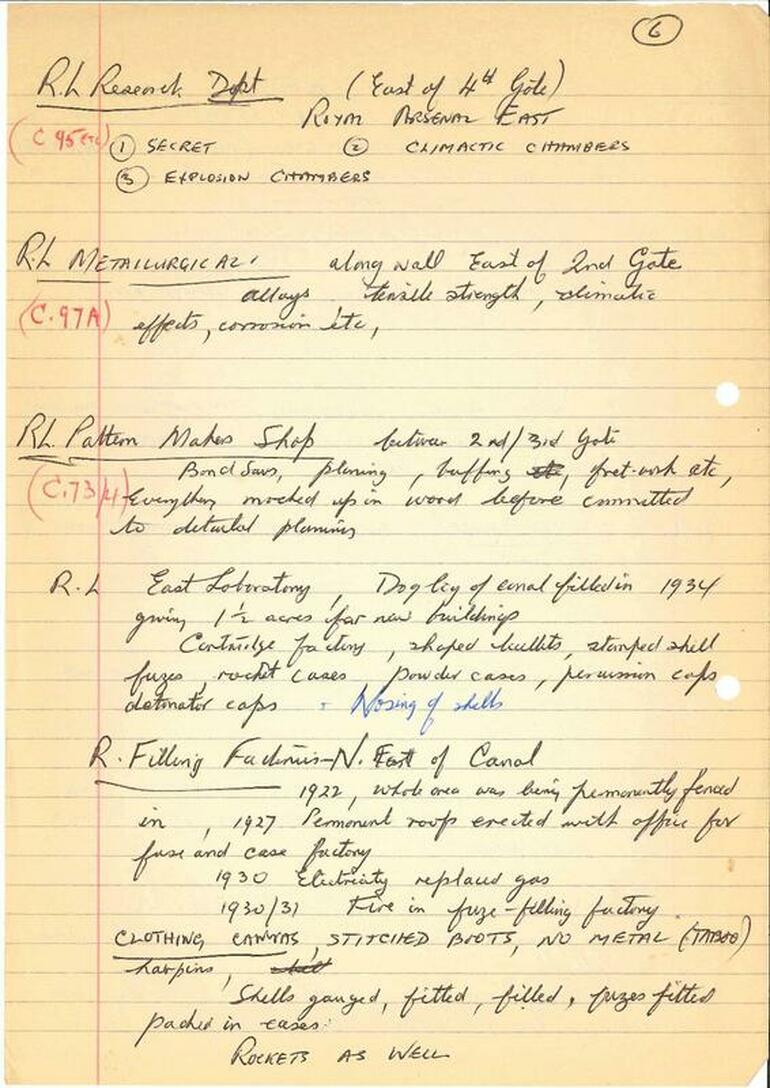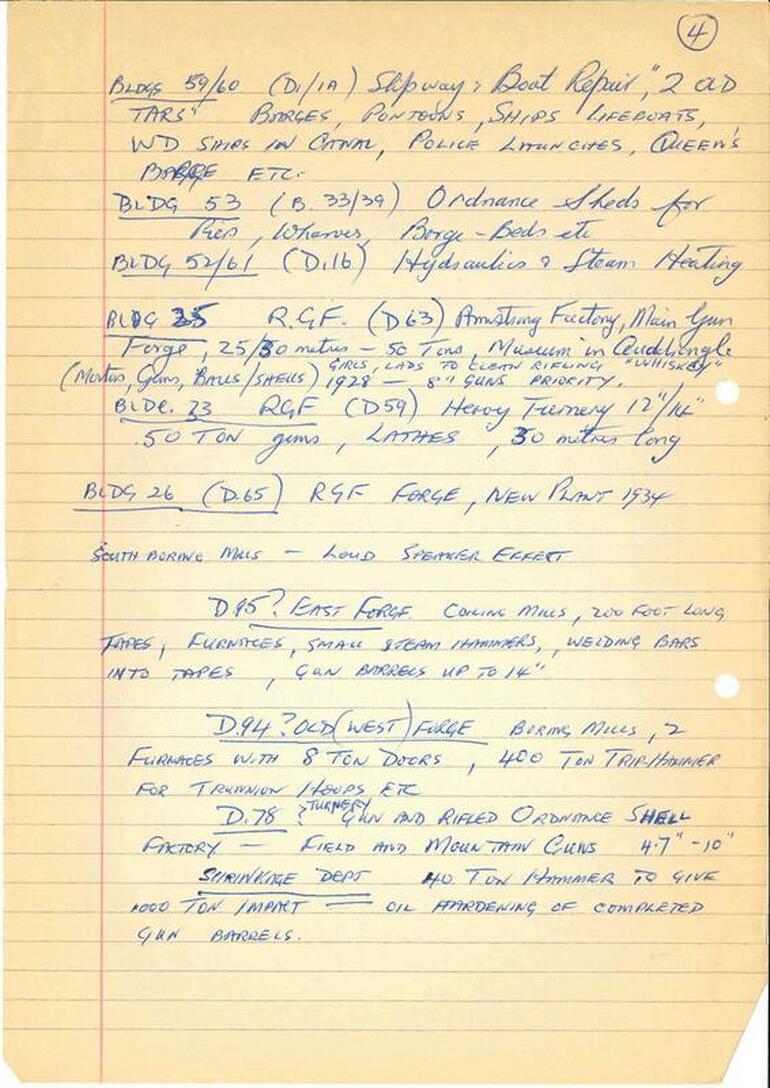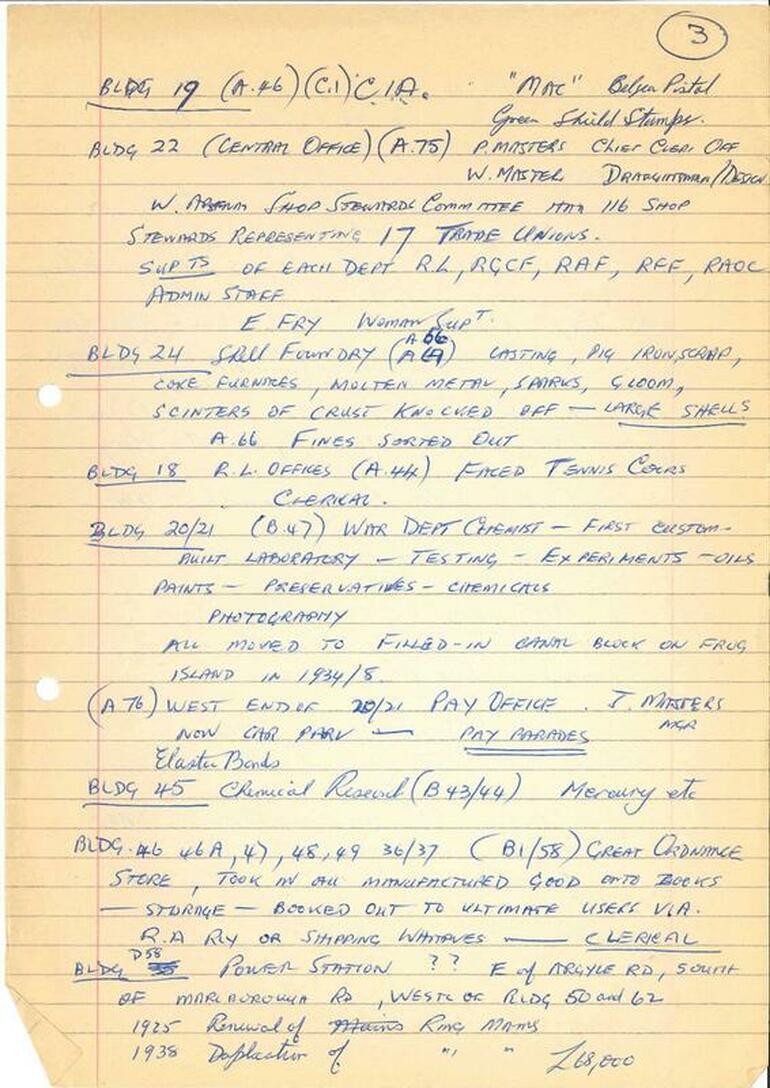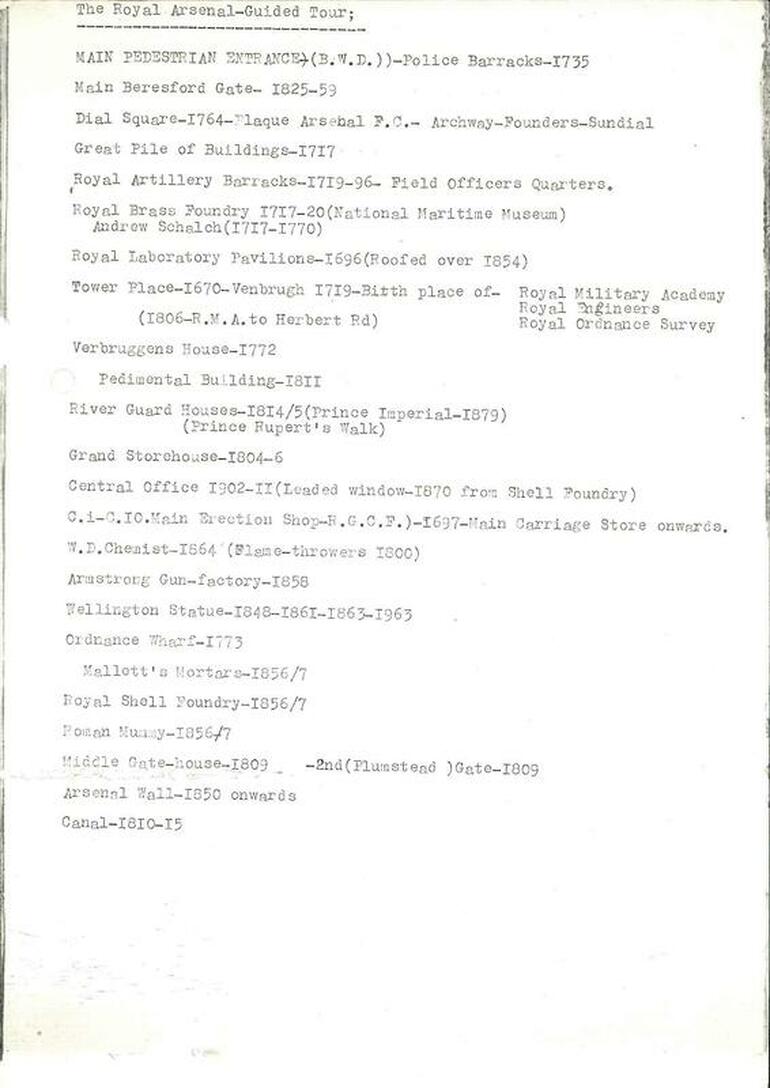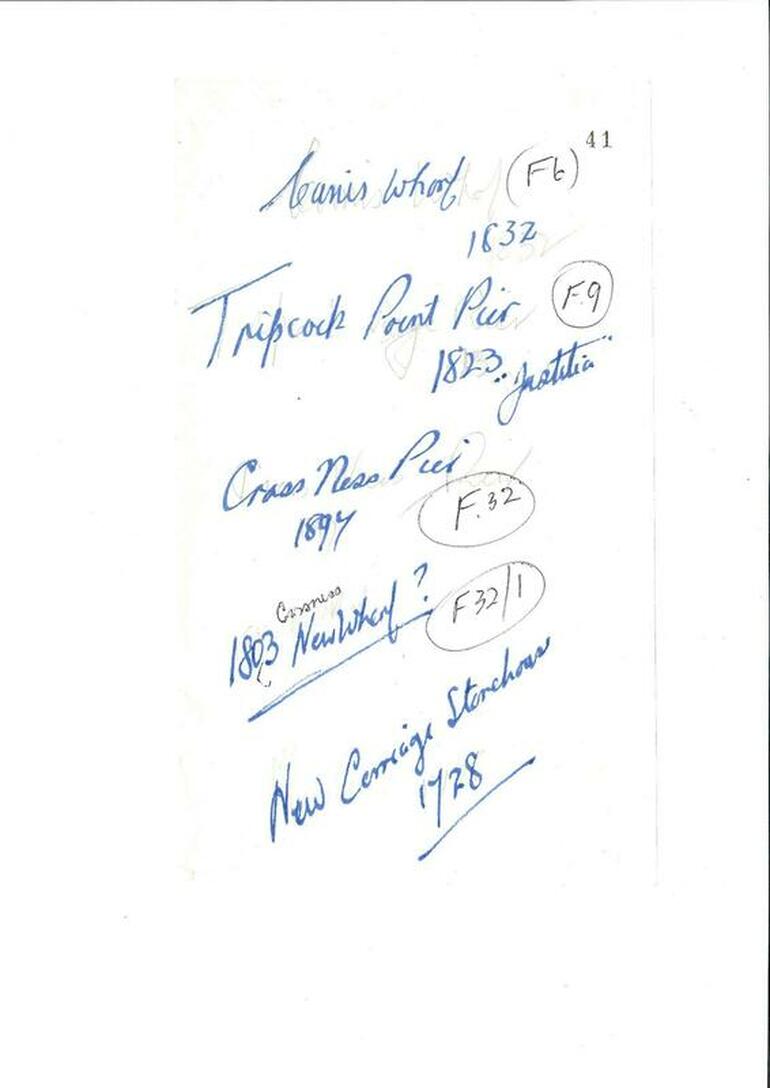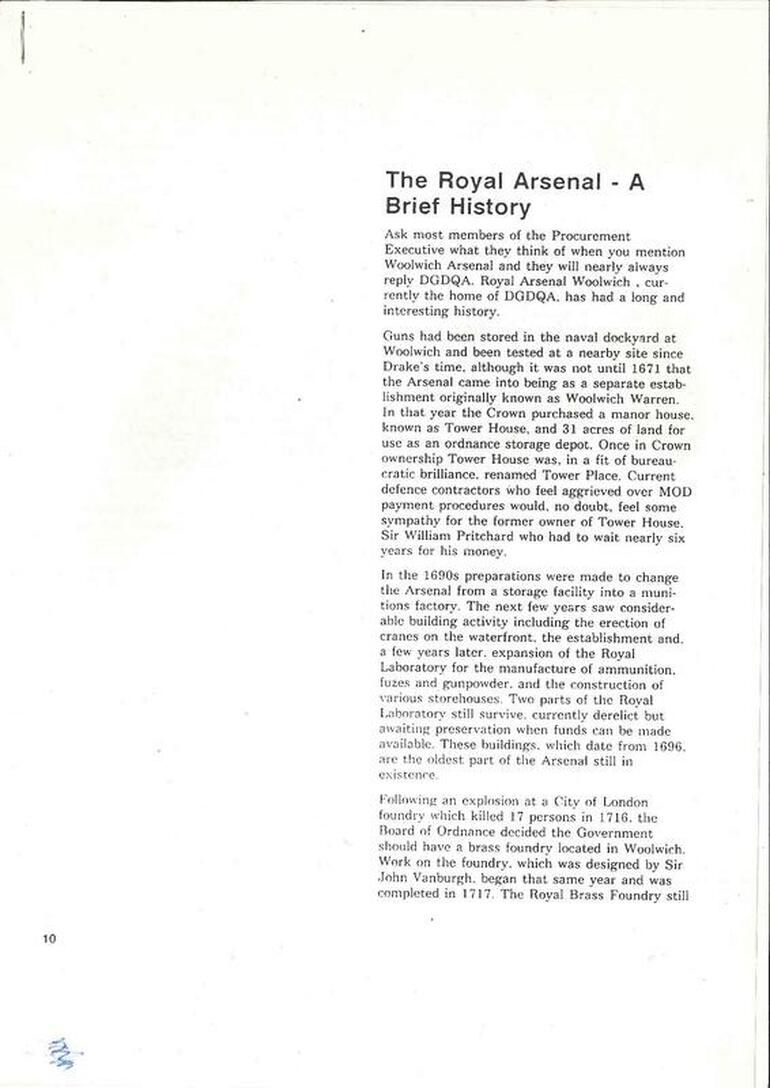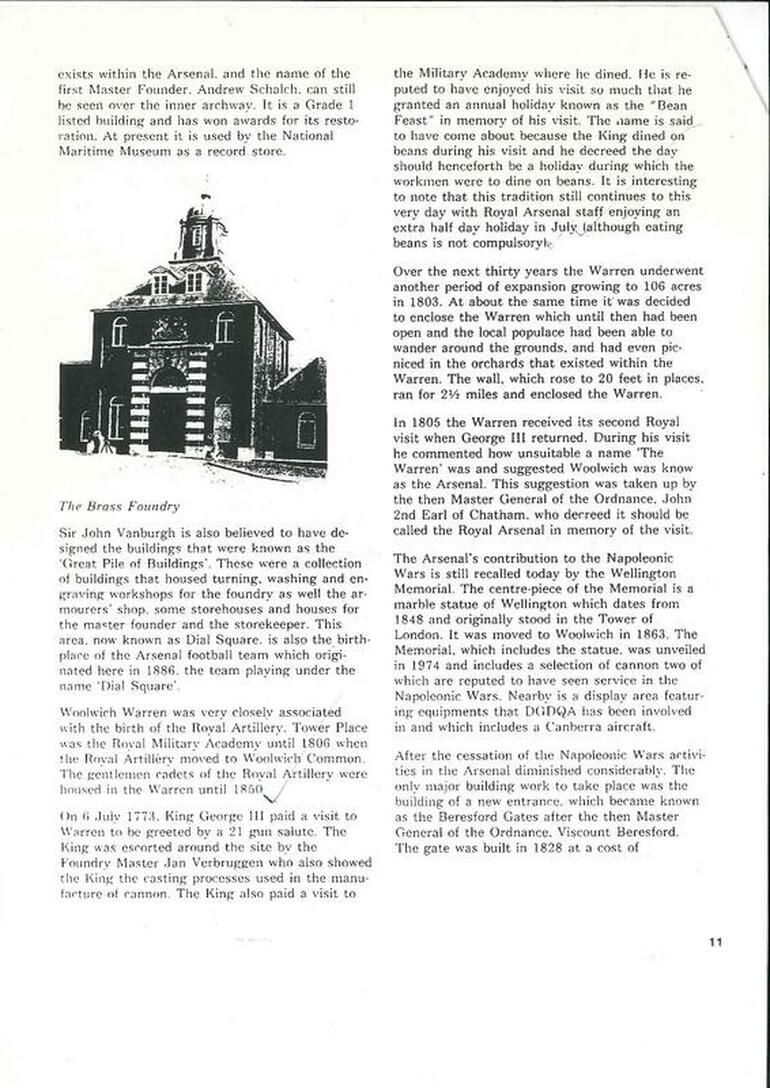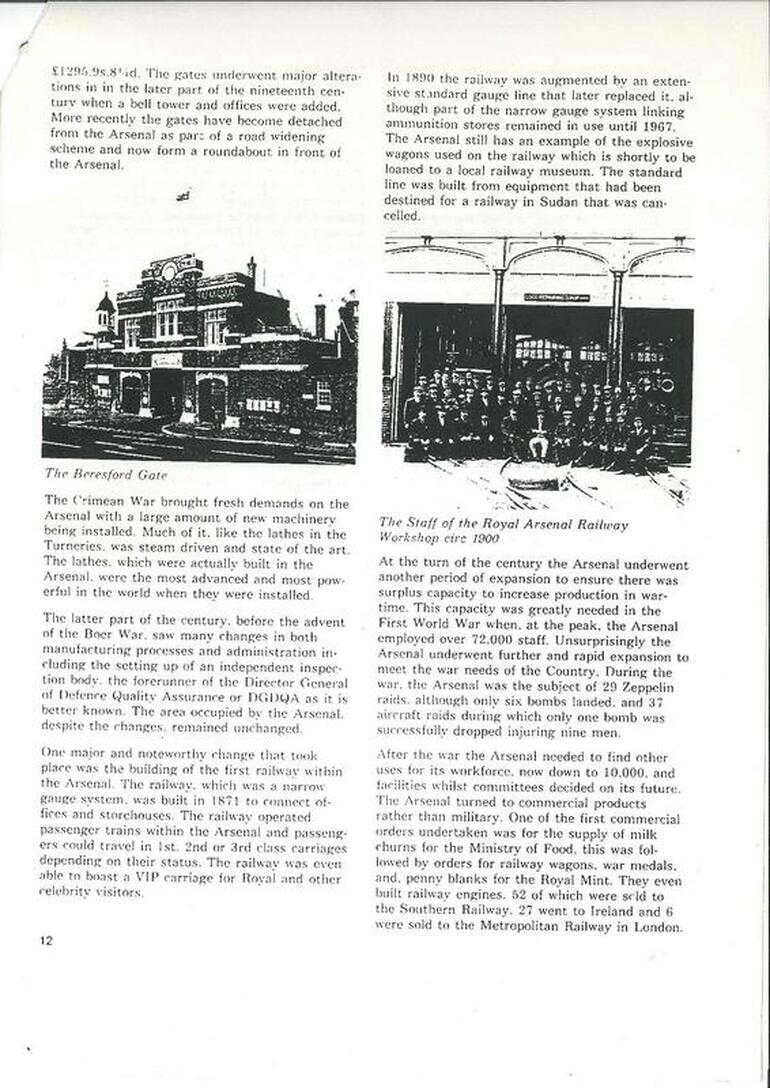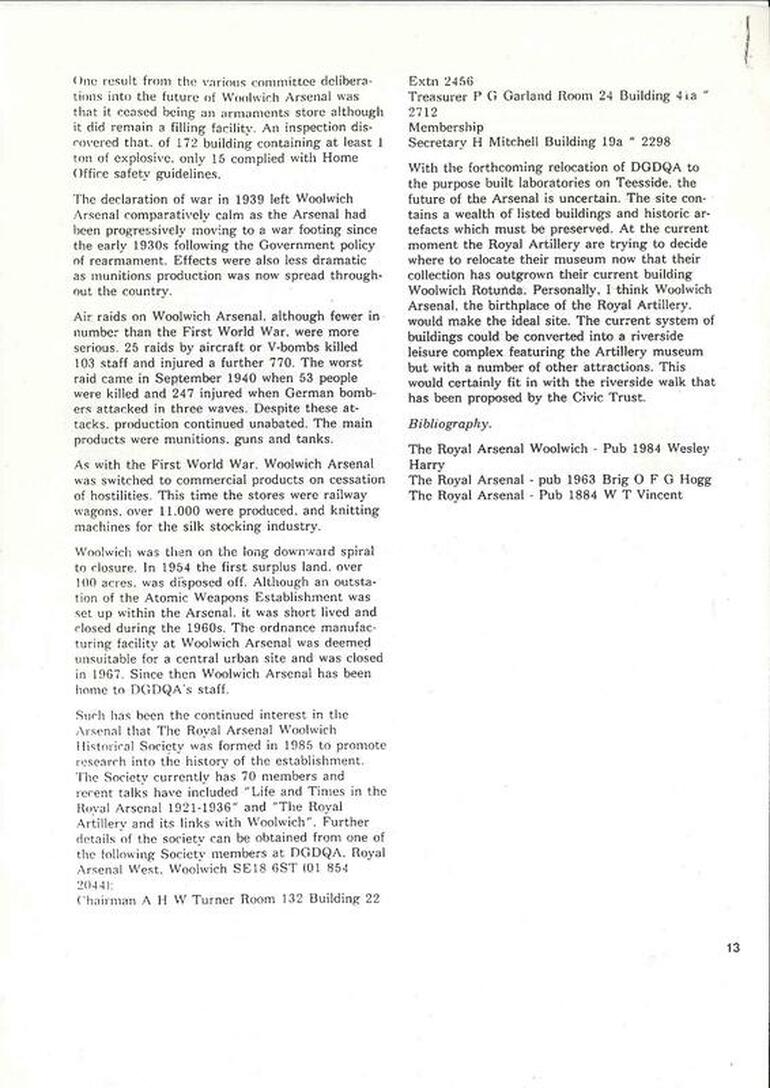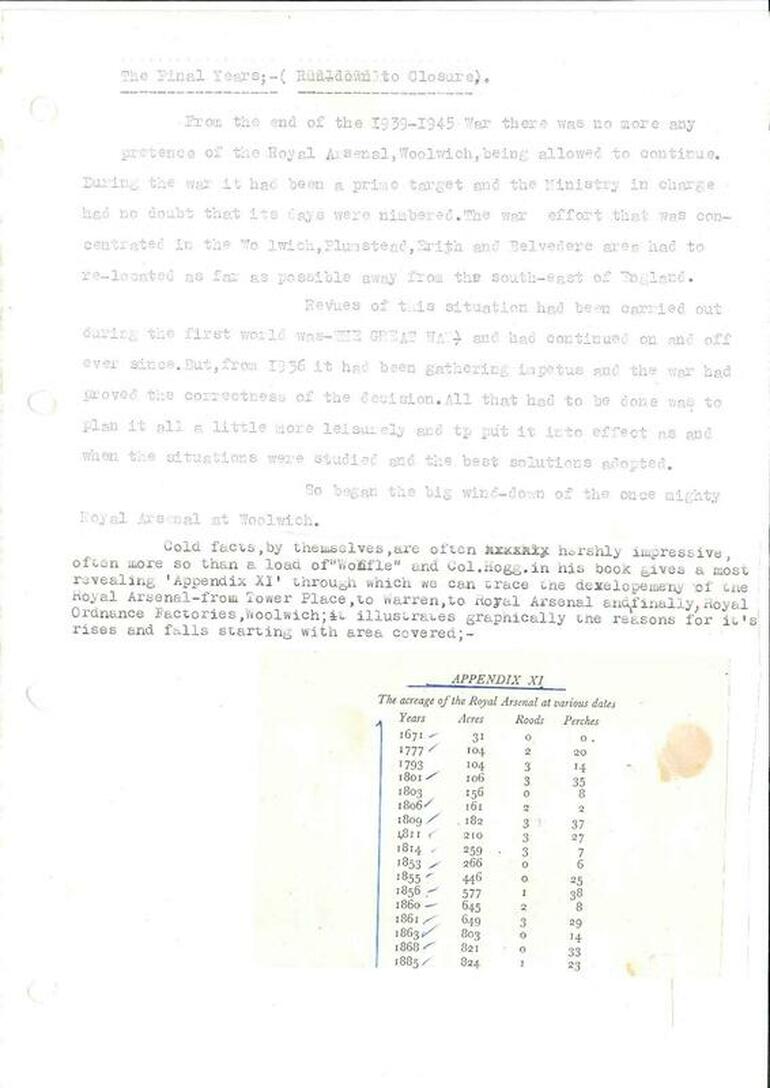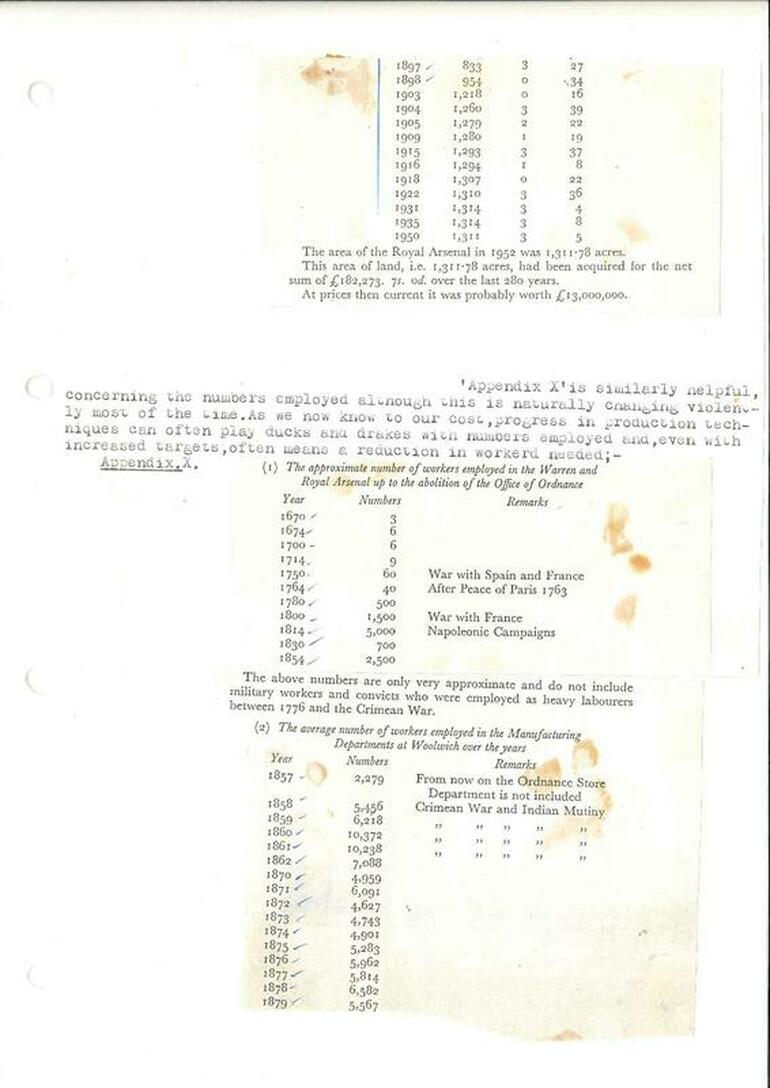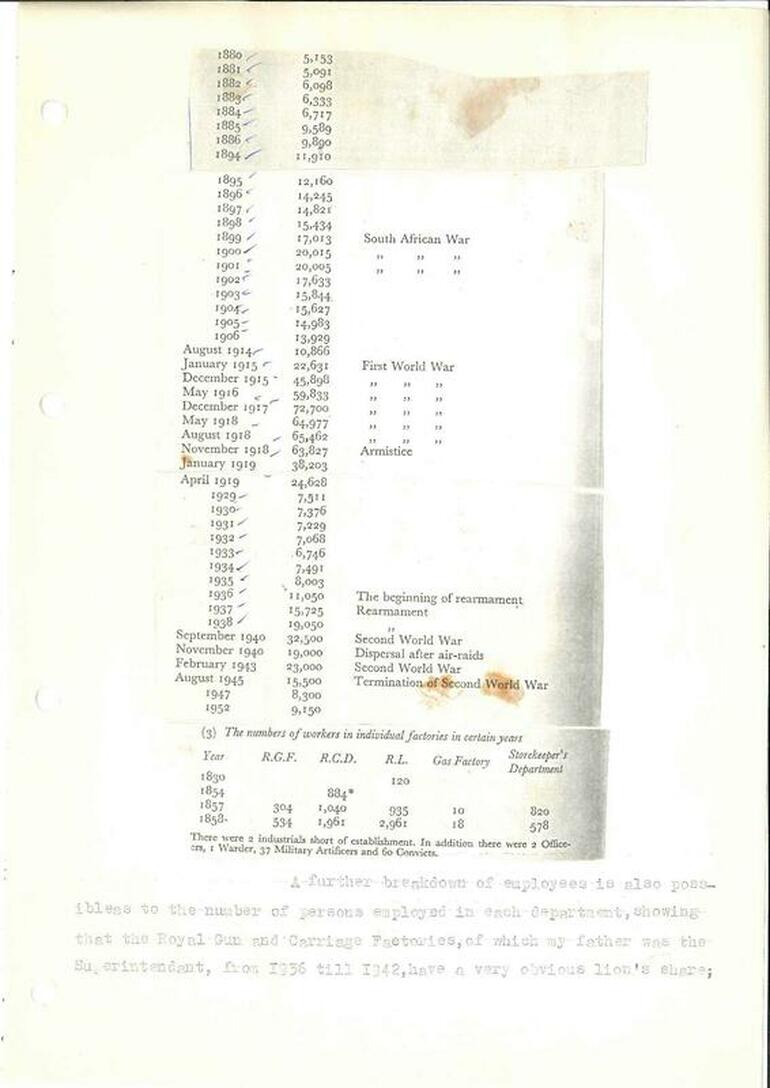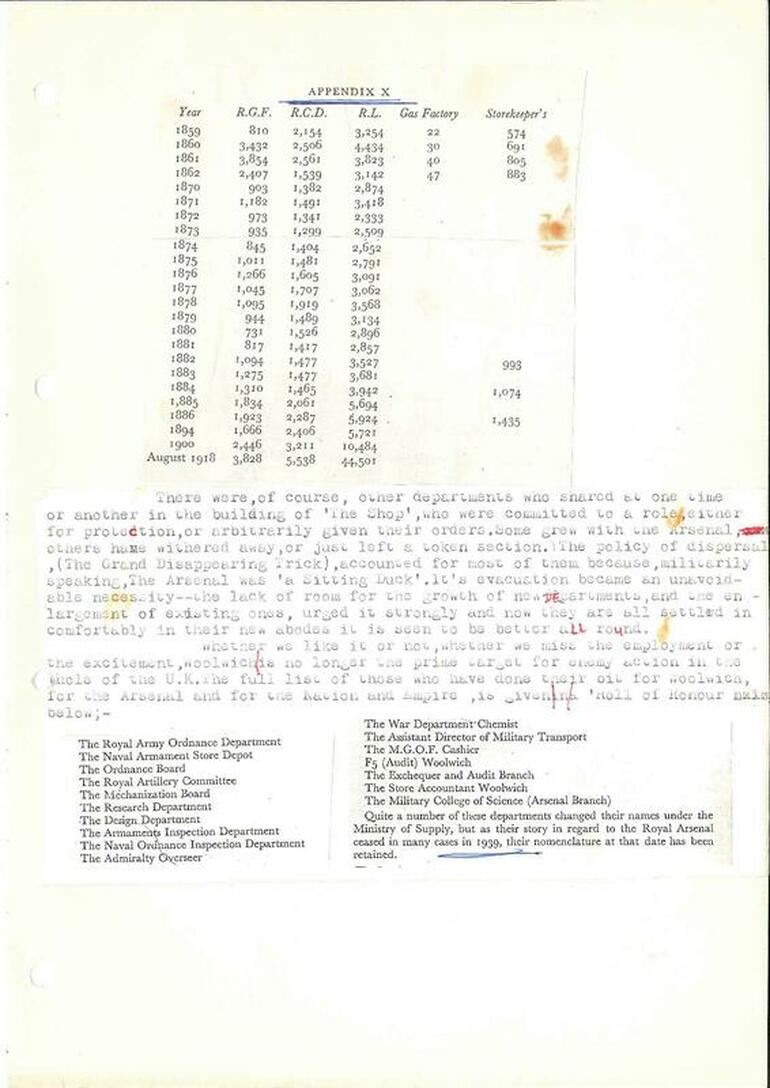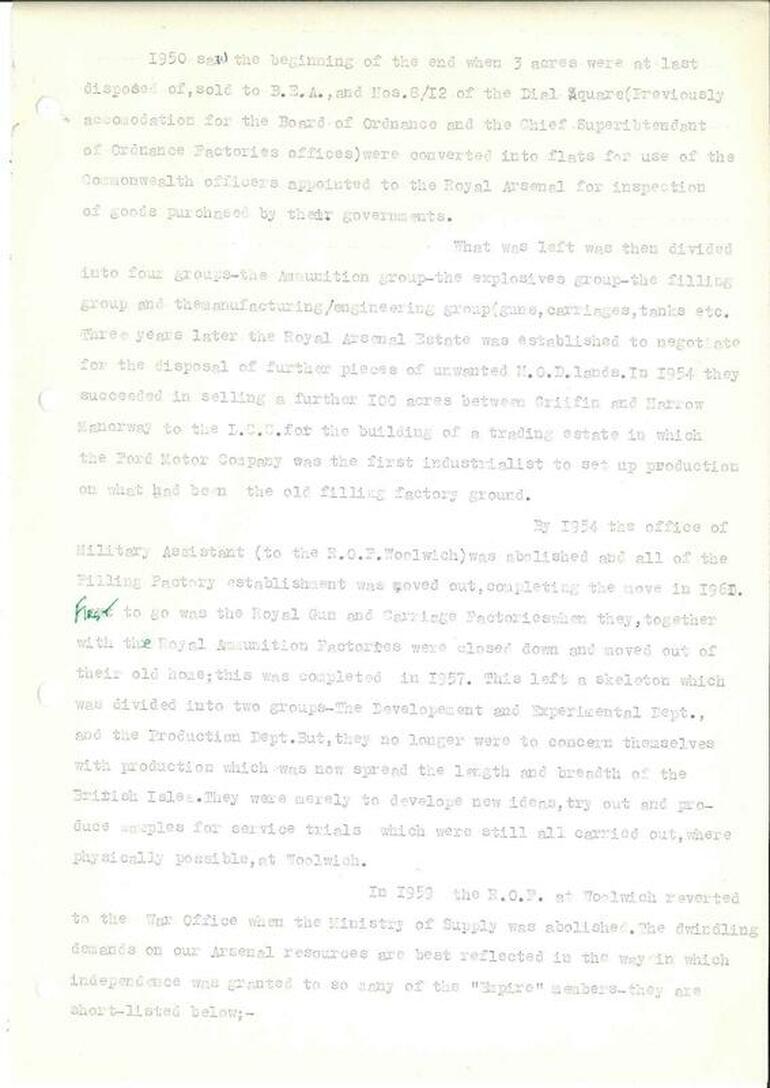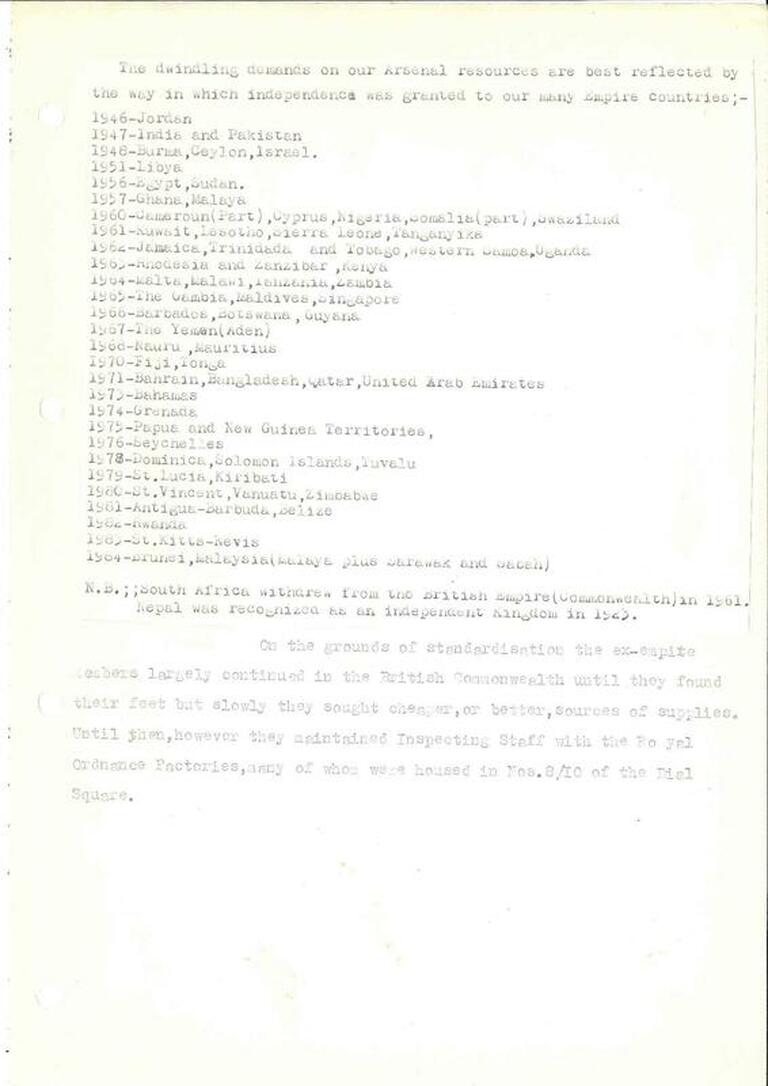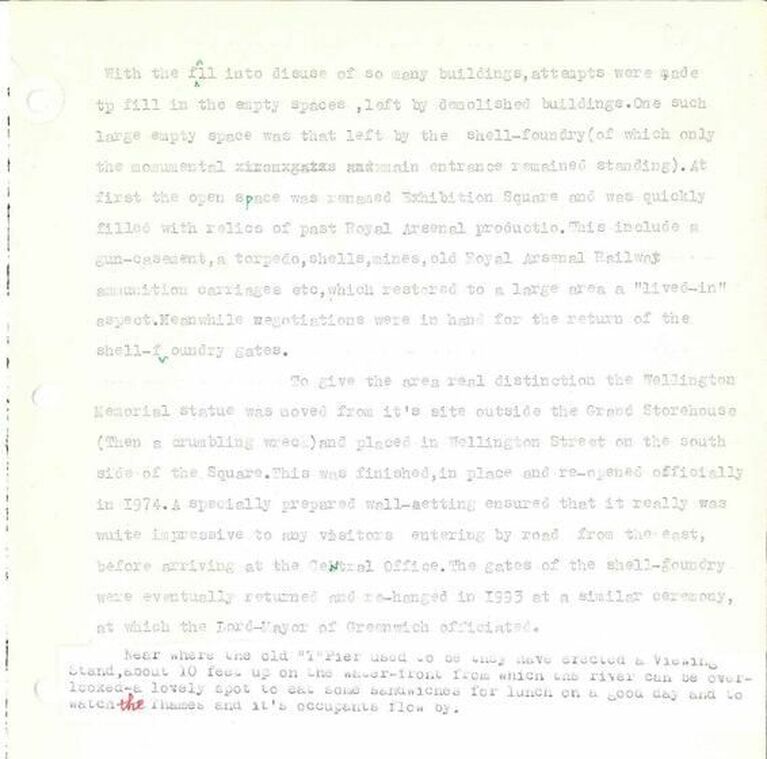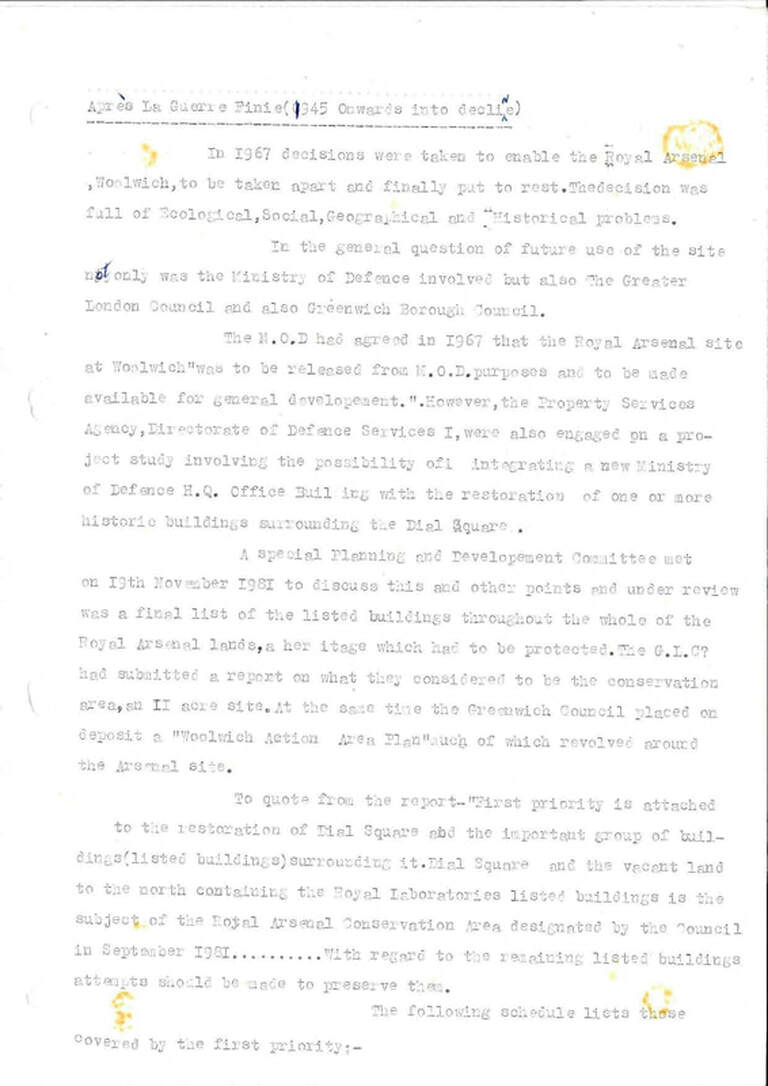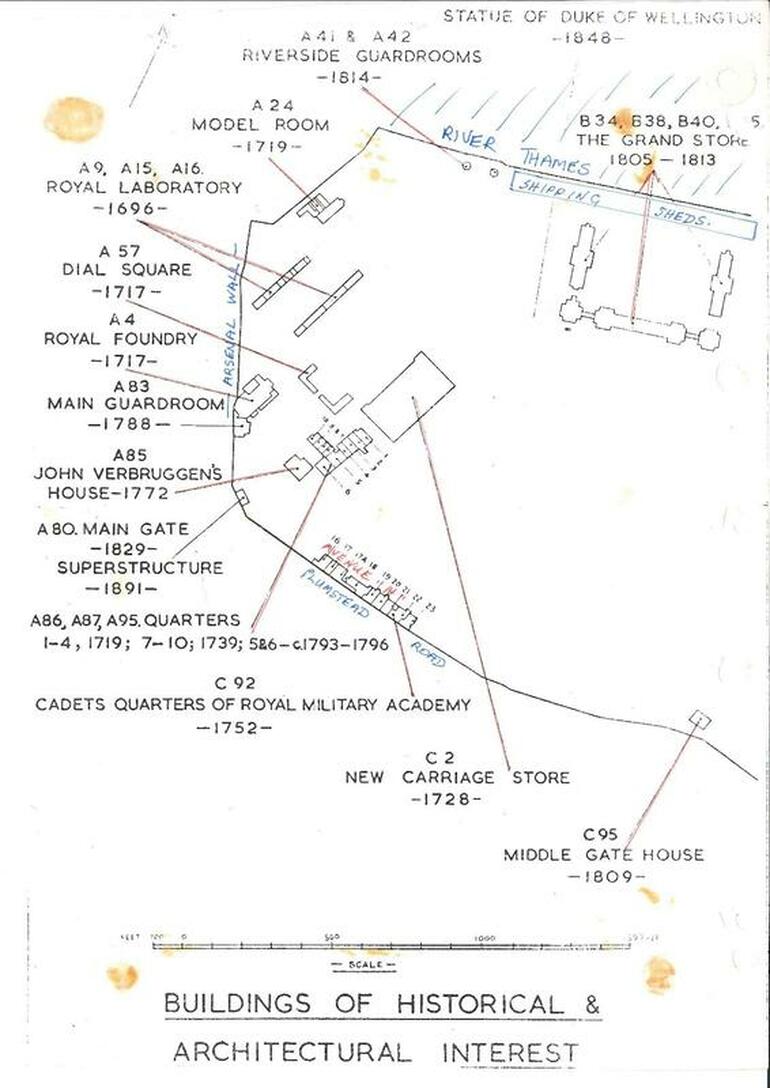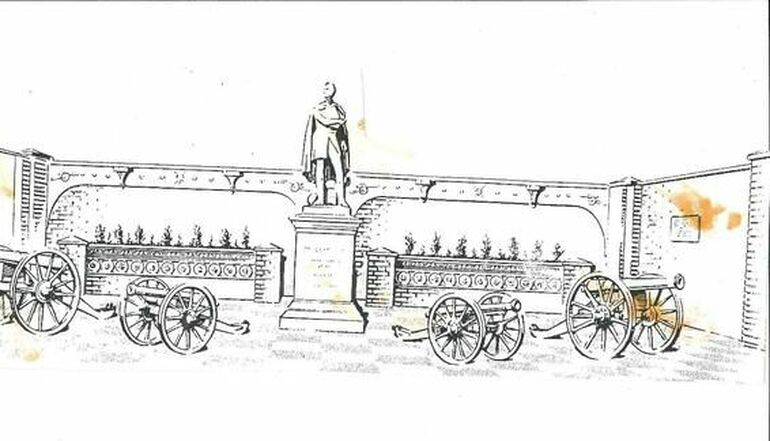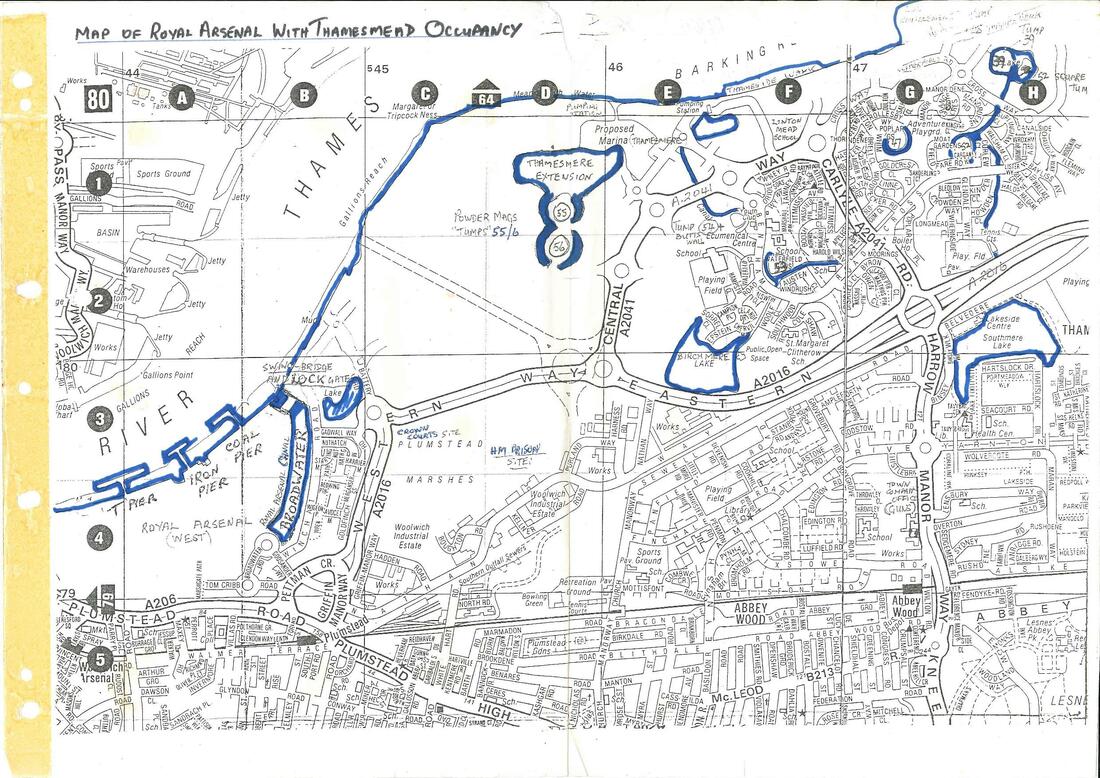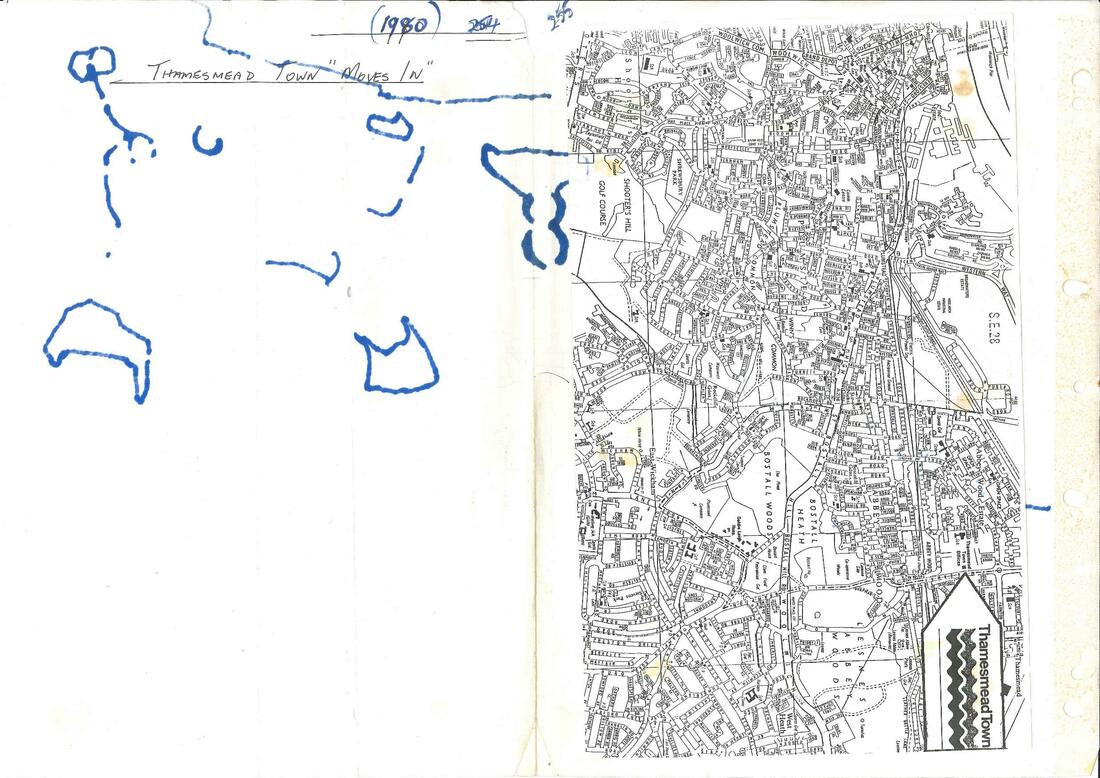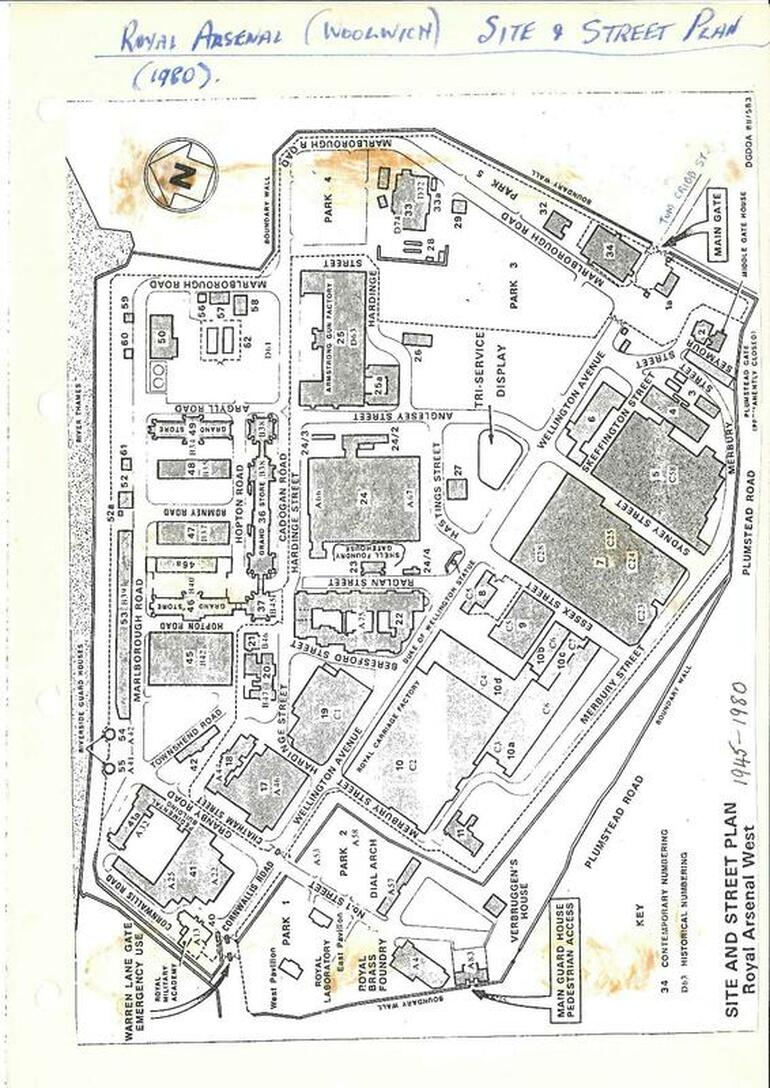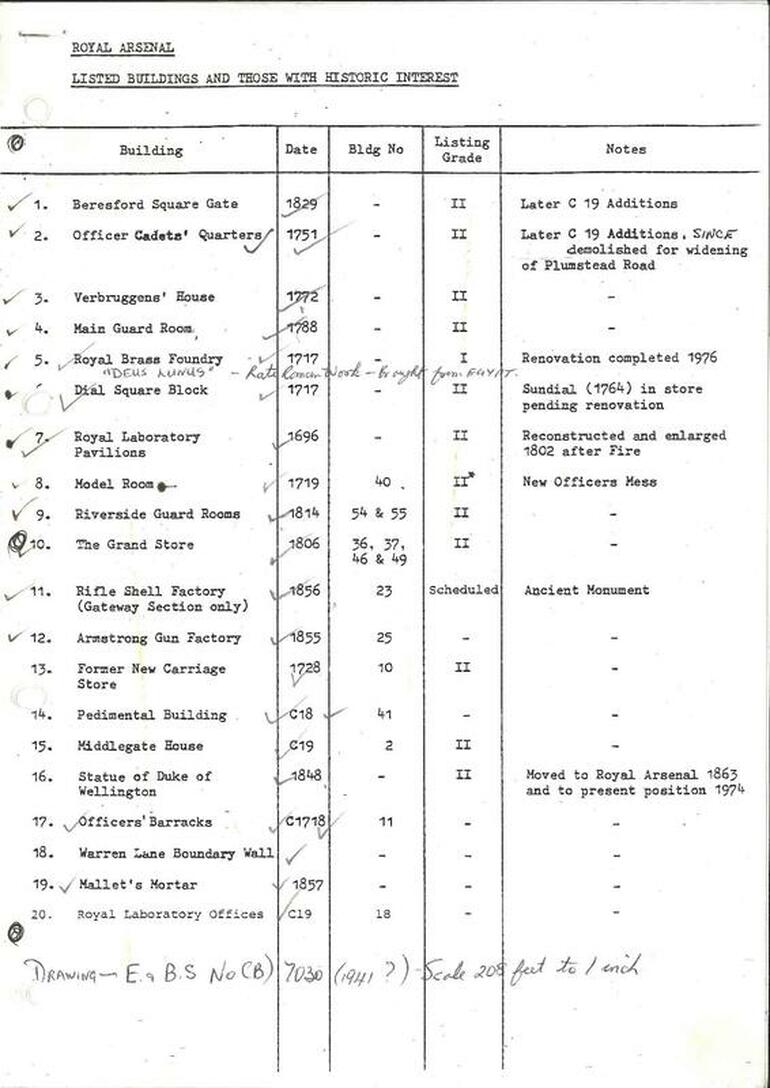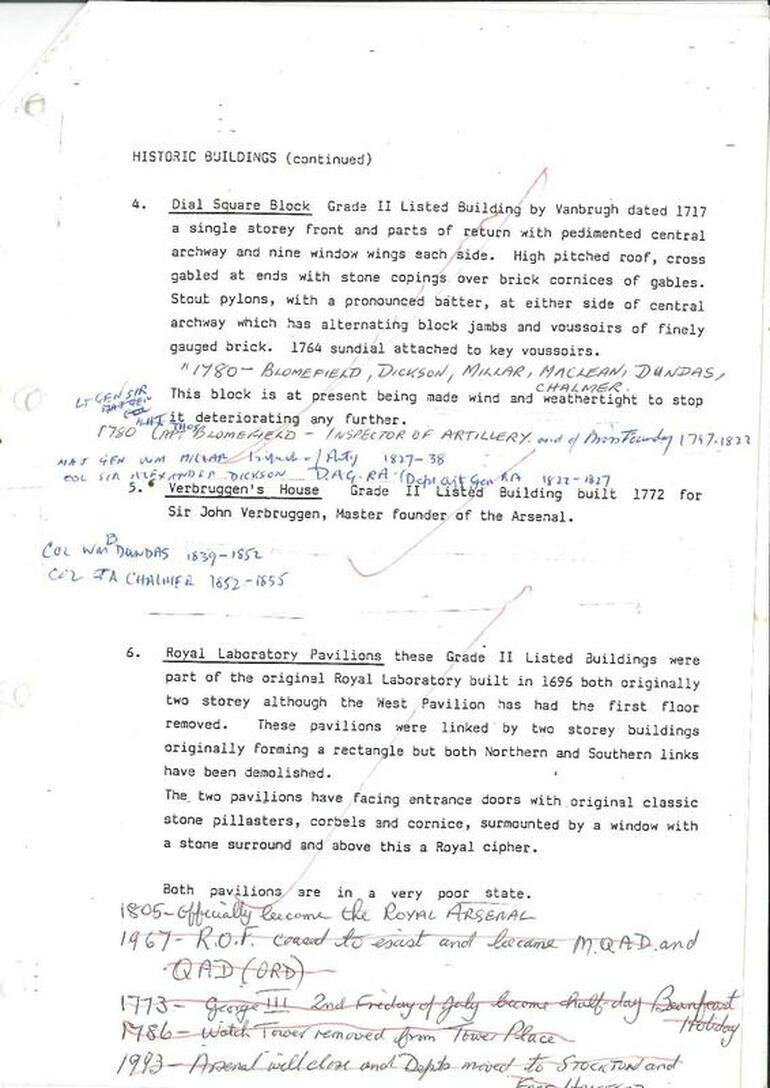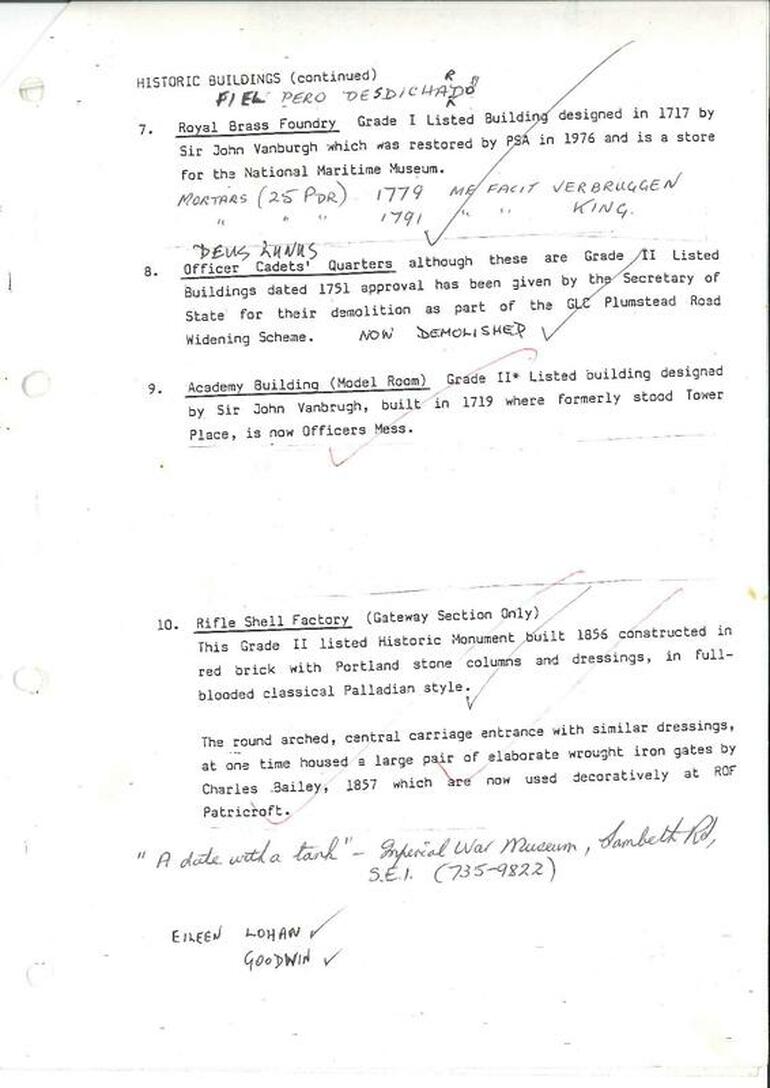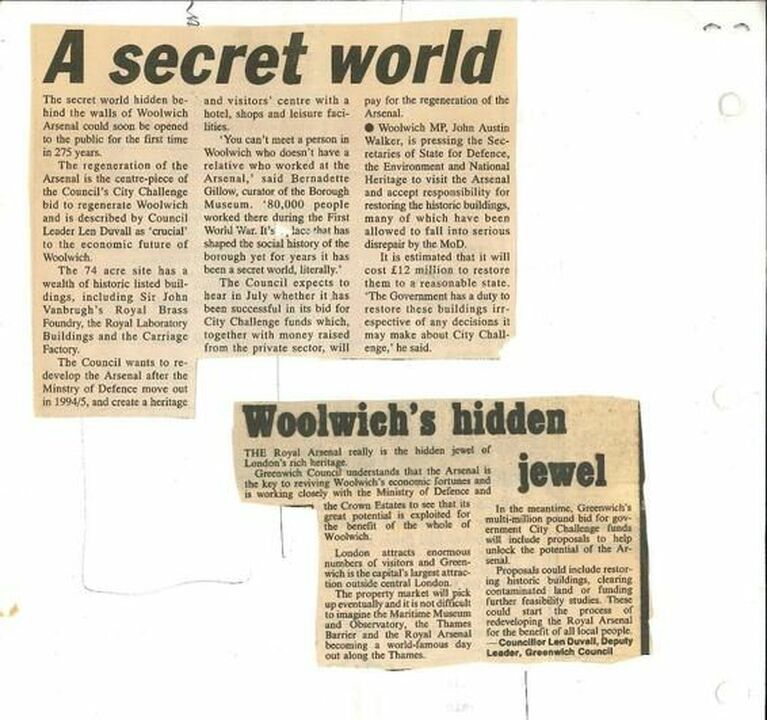Royal Arsenal Final Years 1967 -1994
Royal Arsenal Final Years 1967 -1994 - Draft Green Folder
Scanned 3 - Royal Arsenal Summary reference - Photograph, Sketches, Articles (that would of been included in draft )
Scanned 4 - Royal Arsenal Trading activities (departements), development, random
Scanned 5 - Royal Arsenal Final Years, run down etc
Scanned 6 - Map Thamesmead occupancy 1980
Scanned 7 - historic buildings - Listing - A secret World - Hidden Jewel
1964 The decline of Woolwich, The significance, history, character, decline, markets, ferry, theatres, landmarks
Discover the rich history and culture of Woolwich in this captivating video that explores the significance of the Woolwich Arsenal. Watch as the video delves into various topics, including the declining significance of Woolwich, the impact of the possible closure of the Arsenal, and a petition to Parliament against the decision. Learn about the importance of the Royal Artillery and the Royal Military Academy, the expansion of the size of armaments and the workforce in Woolwich, and the history of the local theatres and the Mod era in Woolwich. Immerse yourself in footage of various landmarks, such as the Woolwich Ferry, the Woolwich Covered Market, Beresford Square, and the former Royal Artillery Theatre. The narrator expresses concern about the declining population of native-born Woolwich residents who are leaving the area, emphasizing the importance of preserving the area's unique heritage and character. Click the link to discover the hidden gems of Woolwich and its historical significance.
In 1964, during the Charlton Athletic versus Norwich City Division 2 League match, a sequence was captured from different areas of the Charlton stands, including the back, mid-stands, and closer views. The footage showed Norwich City's Bill Punton dribbling the ball forwards, while the largely male crowd, with a few women and girls, clapped in appreciation. The narrator commented that 60 years prior, on a Saturday afternoon, Woolwich Arsenal workers would have played for the Arsenal team. However, the narrator lamented that the modern-day Arsenal players do not care much about their origins. A still photograph of the 1905-6 Woolwich Arsenal League Team was also shown.
As the narrator discussed the declining significance of Woolwich, workers were shown leaving through Woolwich Arsenal's Middle Gate on Plumstead Road. They departed on foot, bikes, and in cars, with a VW Beetle leading the way. Policemen were seen directing traffic on either side of the Royal Arsenal Gatehouse on Beresford Square. The narrator warned that the arsenal might shut down unless people like Frank Glasson fought to keep it open. Frank Glasson, dressed in a suit, was filmed sitting on a wooden bench at Shrewsbury Park. The camera captured him from the front, in close-up, and from behind, looking downhill over Woolwich. The panoramic view included Plumcroft Primary School. A closer view over the rooftops from the park showed the Rockmount Estate and panned to Woolwich Power Station. Mr Glasson spoke about his long service at the Arsenal, the impact of a possible closure, and a petition to Parliament against the decision. The scene then shifted to views of the Houses of Parliament and Big Ben, with the beginning of the petition being read out.
According to the narrator, Woolwich had to fight for its survival in the past. In 1906, Arsenal workers, led by Will Crooks, who was the Labour M.P for Woolwich East, organized a rally in Trafalgar Square and presented a petition to the Prime Minister. A still photo was shown of the crowded rally, which included a brass band, policemen, and a large banner demanding "A Fair Share of the Nation's Work." Another photo depicted the crowd at Trafalgar Square, with policemen and rally leaders, including Ramsay MacDonald and Will Crooks (holding the petition) in a group to the side of a lion statue. Former Labour Party leader Arthur Henderson was seen standing in front of the lion.
The narrator mentions that convicts housed in rotting ships used to carry out arsenal work. A print from c.1700 titled "The Southern Entrance to the Royal Laboratory in the Warren at Woolwich" is shown, depicting the gatehouse and cottages, with porters wheeling materials about. Prints from the late 17th and 18th centuries show workers, including convicts, under supervision near sheds at Woolwich Warren and inside the workshops. An early Victorian print shows three young people, one of whom is clearly a child, operating a basic machine. A drawing depicts "Girls Making Cartridges for Enfield Rifles at the Royal Arsenal, Woolwich, June 1862." Victorian prints show men at work in rows on small armament manufacturing machinery in a vast factory, foundry workers at the furnace, casting pits of molten metal, a man cleaning a large machine wheel, a man working on a large cannon barrel, soldiers preparing a cannon for firing using rammers, and an "Armstrong gun" cannon barrel being lifted by crane onto one of many similarly loaded pallets of "Woolwich Infants." The narrator notes that by the 1870s, the arsenal had a dominant role in imperial and local economic growth, and discusses the expansion in the size of armaments, the workforce, and Woolwich. WW1 photos are shown of working men in caps being shown a document by a uniformed soldier, women making bullets in a huge factory with belt-driven machines in the background, and men posing by their shell-making machines (with, in one case, a wall of sandbags for safety). The narrator emphasizes the Arsenal's national, historical, and local importance in WW1
Christopher Mayhew, the M.P for Woolwich East, is shown in a close-up as he expresses his view on the importance of the arsenal in defending the liberty of the Englishman. A still photo of artillery guns outside the Royal Artillery Barracks is also shown. In an out-of-focus residential street, a young man with his tie askew drinks a glass of beer in a fenced grassy area, while a lorry passes by. A few men are playing cricket in a park. Photos of the contemporary Woolwich Arsenal are displayed, showcasing its modern facilities, electronic equipment, and gleaming vertical pipework. Frank Glasson highlights that the arsenal is not outdated and has been modernised, but the government has outsourced work to private firms. He adapts a Churchill quote, "Give us the job. We've got the tools." Finally, a group of people is seen walking by in a view downhill from Shrewsbury Park, to the east of the previous vista.
The narrator provides background information on the locations of North and South Woolwich, which are separated by the river but connected by a free ferry. The Ferry Captain and the narrator emphasize the contrast between the two areas. The camera zooms in on a crew member wearing a black cap through an open ferry window and pans to show the South Woolwich Ferry Pontoon and riverside. The Captain mentions that passengers used to take trips on the old open-deck paddle steamer ferries for leisure. There are still shots from around 1920 of paddle steamers, including the "Hutton," with the North Side Ferry Pontoons and factories like the Tate Sugar Refinery visible in the background. The film shows a side view of the John Burns Free Ferry and then cuts to a close-up of the Captain, who comments that the new ferries are less popular. The film also includes shots of moored small boats, such as the "Voracious," "Vista," and "Racia," and the Captain talks about the different types of vessels and conditions on the river. The camera captures the bow of a sailing boat named the "Banka" moving to the east of the South Woolwich Ferry Pontoon, and a small ship passing by the ferry. The film then shows a travelling shot of the top of the South Woolwich Ferry Pontoon and the entrance to the Woolwich Foot Tunnel, with cranes and vessels in the background. There is a view of the river, banks, and barges over the ferry rail, and the Captain speaks about how his family influenced his decision to pursue a career as a ferry captain, the joy it has brought him, and public recognition. The film shows shots of sunlight reflecting on the river water and a hazy river scene with barges. There is a shot of the Woolwich ferry bell, with the ferry behind it loaded with cars, including a Ford Anglia E494A and the back of a Morris Minor Traveller. The camera then focuses on the Captain on the ferry, with Woolwich Power Station partially visible. As the ferry docks, passengers of all ages board, and a car ramp lowers. At the Captain's signal, the first car, a Morris Minor Tourer, leaves the ferry, while a boy on a bicycle waits.
The next scene show an aerial view of the River Thames, West Woolwich, and the Greenwich Peninsula, while the narrator discusses the impact of modern influences. The camera then cuts to a street scene, likely Powis St, where women and a few men are walking and talking, including an attractive blonde in a stylish sweater. The film includes a close-up shot of a black girl with an impressive afro-beehive hairstyle standing by a large mosaic pillar, possibly located at Woolworths on Powis St. The scene then shifts to Powis Street, which includes Garretts Department Store, light traffic, pedestrians, and ongoing building work. The camera pans across to show wedding dresses in the Ashley Ceres shop window opposite. The narrator comments on the older generation's "caution, enthusiasm...bewilderment" towards young people's wealth. The film then features a gym sequence, which was likely filmed at Universal-Figurama (House of Venus) located at 112 Powis St, above Broadmeads. Young women can be seen using resistance machines to tighten their inner thighs, bottoms, and arm muscles. The machines pump while one woman swings a pole on her shoulders, another receives a vibrating stomach massage, and two others do sit-ups and lift weights. The film then shows a man doing a woman's hair in a mirrored salon, and a young woman lying in a flotation tank with only her head visible. The film ends with a shot of a woman wearing a tape measure around her neck as she walks through swing doors to the equipment room, while the narrator comments on the cost.
The scene opens with elderly people on the street near Beresford Market, with stalls and barrows lining the area. The men are often seen wearing flat caps, and background vehicles such as a Mini, a VW Beetle, and a Mini Van can be seen. Close-up shots of the people reveal an old man who appears to have left his false teeth out. An older woman talks about past poverty in contrast to current affluence. The scene then shifts to shots of the Woolwich Covered Market and the people who frequent it, including budget-conscious signs. A dress fabric stall owner, perhaps "Stan's," attracts customers with his lively patter, while his wife spreads fabric for customers. Other vendors include a florist, a sweet stall, a greengrocer's, and a huckster selling baked goods. Older men sort through clothing while youths mill around, and a young woman in a leather jacket eats an ice cream while browsing, using her motorcycle helmet as a carrier bag. The narrator approves of the range and price of goods, but implies the quality and taste aren't always as good. He talks about different kinds of trade - bargains, family businesses and hucksters - and highlights the excitement and energy of the market.
night scenes around Beresford Square. The Royal Mortar pub is shown from the outside, with its frosted window and customers visible inside. A singer performs a wartime song for the patrons, and close-ups of the bar and its surroundings show the beer, till, and customers enjoying their evening. The band starts up again, and the camera lingers on close-ups of the instruments and players, capturing the lively atmosphere of the pub. A still photo shows the north-west side of Beresford Square, with people waiting outside the Century cinema and neon signs for a betting shop and surgical appliances shop visible in the background. The Odeon Cinema and Gaumont Cinema are shown lit but empty, with a banner for "Girl With Green Eyes" visible on the Odeon's front. An elderly man laments that people don't go out as they used to, and a still photo of an almost deserted street by The Elephant and Castle and Ordnance Arms pubs on Beresford Square brings the film to a close.
An elderly lady and gentleman reminisce about their childhood memories of Sunday morning Church Parades on Woolwich Common. The narrator presents still photos from the late 19th or early 20th century of the Royal Artillery band, a massive parade, and crowds gathered outside St George's Garrison Church on Grand Depot Road. The images show the grand church, the crowds at the Royal Artillery Barracks, and a grandstand possibly erected for a race at the Royal Military Academy. The narrator notes that these parades no longer take place and the church now lies in ruins. However, once a year, the Royal Artillery puts on an "At Home" pageantry display in the rain.
Moving to 5/6/64, the scene shifts to the Royal Artillery Barracks where children run through puddles on the parade ground to join the back of a crowd that's gathered to watch the "At Home" display. The drum major and trombone players perform behind a fence that separates them from the spectators. Close-ups of children watching the performance, while others wander behind them and a distant parking area. Soldiers with tubas, drums, and clarinets march past fenced off crowds, an unfenced VIP enclosure, and children sitting on cannons. The scene ends with a still photo of the Royal Artillery Barracks from a distance.
As the narrator continues the story, we see an 1860 engraving of the "Royal Military Academy, Woolwich, Kent." The image depicts a parade, a couple of soldiers.
The next scene takes us to the history of the Royal Artillery and the Royal Military Academy. The narrator explains that the growth of the Arsenal led to the establishment of the Royal Artillery Barracks and the Academy, which had to be rebuilt after a fire in 1873. A part of an 1873 engraving showing firefighting/rescue operations is shown. Next, we see a print of the Royal Artillery Barracks, with soldiers, cannons, and onlookers in the distance, dating back to around 1840. A print of a crowded dock scene is shown, depicting horses being loaded onto a vessel, likely for the Napoleonic wars. We also see a print of Royal Artillery soldiers firing a Congreve rocket during those wars, with cavalry officers in the background, one waving a sabre.
The importance of artillery is discussed, with a close-up of a modern artillery gun firing. We see the King's Troop, Royal Horse Artillery making their famous 'musical drive', part of the "At Home" display, probably on Woolwich Common, with uniformed cavalry pulling gun carriages or holding sabres as they gallop past soldiers with marker flags in front of a distant crowd. A C19th print of the Royal Artillery in the heat of battle is shown, followed by a still photo of a Royal Artillery howitzer at the Battle of the Somme. A WW2 still photo of a manned Sexton II Self-Propelled Gun (SPG) is also shown.
The Royal Artillery Barracks is shown, with a heavy mortar and the base of a Crimean War Memorial in the foreground. A couple of large cannons on iron garrison carriages and a couple of large field cannons are also shown in front of the Royal Artillery Barracks. Small silverware statuettes of manned cannons and cavalry officers are shown, including a piece presented to Sir Huw Ross on his retirement in 1858. Views of the Royal Artillery Barracks and a nearby avenue of trees are shown, followed by a long shot of the Royal Military Academy. Travelling shots past modern accommodation blocks, including the Colenso Barracks and Inkerman Barracks, are shown, along with a shot of a soldier washing a window. Finally, soldiers are seen marching inside the West Gate of the Barracks, behind the modern blocks.
A Mini Van is seen driving up Church Hill, passing by various vehicles including a VW Beetle and possibly a Messerschmidt bubble car. It travels through the churchyard gates and comes to a stop by the church steps. The narrator introduces Nick Stacey, who wears blue jeans under his cassock and is a skilled PR man. Nick Stacey discusses the lack of interest in the church within the riverside communities, but expresses that the people are friendly. Views are shown across the river from the front of the churchyard, with a hazy shot of barges, ships and loading cranes moving near the rigging. The scene changes to a long shot of terraced houses on Wickham Lane, Plumstead, with a car driving towards the end of the row, where a house has been demolished. The camera then shows residential tower blocks on the Rockmount Estate, including one with silver birch trees and another with a woman leaning on the balcony of her flat. The shot pans out to display other blocks and a hazy view downhill.
Nick Stacey reflects on the current state of society, noting the lack of recognition for the role of the church in an increasingly affluent world. Despite this, he observes that people are slowly and painfully discovering that "man cannot live by bread alone". The scene then shifts to a busy street, possibly Hare St, where a two-door Vauxhall Viva pulls up next to a "Radio, Television, Lighting" shop. A young woman steps out of the car as pedestrians pass by a "Fine Fare" supermarket. Shop windows are adorned with notices urging consumption and advertising deals, such as "Look! at these wine bargains...Tomorrow may be too late. Get some today" at Fine Fare, and "Friday Night is Family Night" at another supermarket for evening shopping. Inside a busy electrical store, people mill around, perhaps shopping for radios, televisions, or lighting equipment. The scene then cuts to what appears to be a graveyard, with a Silver Cloud Rolls Royce parked by the gate, likely belonging to a funeral director. The view pans out to reveal a three-storey residential terraced street beyond. A young man sits in the driving seat of his car, smoking a cigarette as his car is hand-washed. The camera peers through the water-sprayed windscreen, revealing a dark, hazy figure in the distance.
Inside a betting shop, rows of cashiers count bundles of money and stamp betting slips while odds are displayed on a betting board. Punters, predominantly white men with the exception of a young Chinese-looking man and a couple of barely visible women, listen to race commentary and betting odds, smoke cigarettes, lay bets, and read the sports pages of newspapers. A bookie scribbles the odds on a blackboard behind the cashiers. Meanwhile, Nick Stacey expresses hope that individuals will begin to reflect on the meaning of life.
A mixed-race couple, with the groom dressed in a plain black suit and the bride wearing a stunning full-skirted white wedding dress with a high veil, emerges from Woolwich Town Hall Register Office as happy newlyweds. Their wedding car, a Ford Zodiac, reflects the couple as they leave with an incidental view of Market Street. Through the car window, we see an older couple, presumably the bride's parents, and a young bridesmaid waving goodbye. Nick Stacey discusses the positive effects of affluence on honeymoon destinations. A shot through the front window captures the car turning into Calderwood St, followed by a close-up of the bride's face, with a view of C19th houses in the background. The narrator laments the challenge young couples face in finding a place to live and notes that East Woolwich is unappealing due to the age of most homes being at least 60 years old. As a boy waits on his bike at the crossing with Cheriton Drive, the scene shifts to a traveling shot of Tuam Rd. The narrator suggests that West Woolwich, such as Eltham, is more attractive but more expensive. The scene concludes with a view of a sleek new block of flats in landscaped gardens located at the junction of Court Road and Tilt Yard Approach.
Former Mayor of Woolwich, D.S Ramsey stands on the roof of the new extension to Woolwich Polytechnic on Wellington Street, talking about prospects for redevelopment of the Arsenal site, and the possible creation of a new "stilt town" on marshes to the east of Woolwich, which later became Thamesmead. The Woolwich Power Station is in the background. A young man works at a modern drafting table in the Polytechnic, where he is studying architecture. He expresses doubt about the suitability of the built environment in Woolwich as an inspiration. View of houses on the Glyndon Estate, Ann St., Plumstead, with cement mixer. Tilted view of Churchill House office block on Thomas St., with part of the saloon sign opposite. Three children play on a muddy ridge in Felspar Close, with hazy views over Woolwich, the camera panning to show the tower blocks of the Rockmount Estate and parked cars (including, at the front, a Ford Anglia 100E). The student says that he quite likes these flats, but they don't blend in well; and that there are great planning opportunities in Woolwich. Further views of the Rockmount Estate tower blocks; and of a tower block and two lower blocks of flats on the Glyndon estate.
The camera zooms in on Herbert Morrison, who comments on how Woolwich is seen as separate from London and how locals consider Beresford Square to be "going to town". The scene shifts to a view of the Royal Arsenal Gatehouse from the bustling Beresford market. Morrison expresses his approval of the local civic pride.
In Well Hall Pleasaunce, five elderly men are seen playing bowls, with a partial view of shops on Well Hall Road over the wall. From behind two elderly ladies sitting under an umbrella near the Tudor Barn, the camera pans across the Tudor Lawn towards a band playing to a small audience on nearby benches, possibly the regular Friday afternoon concert of the Royal Artillery Quintet. Morrison is then seen sitting in a garden, likely his own on Sherard Road in Eltham, discussing his political career in Woolwich.
D.S Ramsey is then shown standing on the Polytechnic roof, this time with the Town Hall in the background. He talks about his meetings with local youths who complained about the lack of facilities, particularly evening entertainment, in the town centre. An architecture student confirms this and expresses scorn towards the bingo and cinema, but praises the pubs.
Lit signs for The Bull Tavern (14 Vincent Road), Ordnance Arms (Beresford Square), and the Eltham branches of the Odeon and Gaumont Cinemas are seen at night, with the latter having a deserted frontage and current programme titles. A poster for "The Fall of the Roman Empire" is also seen. Daytime signs for the Ordnance Arms and The Royal Mortar (Beresford Square) and the Fortune of War pub (Woolwich New Road/Thomas Street) are visible. An erotic magazine display in a shop featuring titles such as "Frolic", "Hi-Life", and "Best for Men" is shown. Posters for local events such as Screaming Lord Sutch, Brands Hatch motorbike races, and a Christmas Bazaar, as well as political parties such as Labour, Communist, and partially seen Conservative, are displayed on an outdoor wall.
discusses local theatres and the Mod era in Woolwich. It starts with views of the derelict Royal Artillery Theatre and early programmes and promotional material for performances there, as well as in the R.A Barrack Recreation Room and on the Barrack Field. According to the narrator, when the theatre was taken over by a commercial enterprise, the plays produced there were unimaginative, leading to apathy and closure. The Empire Theatre on Beresford Street is also mentioned, with a lit sign advertising the show "Ecstasies". Promotional material for the Empire Theatre is shown, much of it risque, including "Les Femmes Beautes" ("Girls, Fun and Thrills"); "Strip-Teasing You"; and "Skirts and Scanties". A lively montage of stills from such revue shows is included, showing women in various states of undress, on stage and preparing for their shows. The narrator states that the Empire was popular with local soldiers, annoyed local clergy, got good box-office takings, but did little for the cultural scene before closing, to general indifference, in 1958. A still of the demolished auditorium is shown, followed by close-up stills of details from the front of a cinema (the first, at least, from the Odeon Eltham) and a bingo hall (perhaps Granada bingo at the end of Powis St.).
During the Mod era, an unseen man possibly D.S Ramsey says that the beat generation's "mid mod fab gear world" scarcely exists in Woolwich. The camera then shows a man walking along Vincent Road and panning to show the entrance to "The Embers" Beat Club. Inside the club, young people walk, dance, mess around, snog, laugh, smoke, talk and stand around in the crowded club. Some girls have the latest mod hairstyles, and some men wear shades. A group plays music. A couple of girls come out of a toilet door marked "Dolls". Older people discuss young people, fairly sympathetically. Nick Stacey talks about "their imagination, their idealism, their energy". A young man says that he was put off the club by fights, while a young woman says she goes regularly and met her boyfriend there. Finally, the drummer is shown drumming.
The scene opens in a rhythmic dance class at Crown Woods Comprehensive School. Girls dressed in gym shorts form a circle and clap the floor and their hands while a teacher bangs a hand drum. They rise to their feet and move in time with the beat, running and leaping before returning to their kneeling position. The Headmaster, Mr. M.K. Ross, walks down a corridor and explains that the school has replaced various segregated institutions. Children are seen playing at the edge of a pond with fountains and a modern bird-like statue. Mr. Ross looks down from a window at groups of boys and girls in the playground and explains that the school is very large and has many departments which they consider an advantage for children's development, despite initial parental reservations. In a classroom, children mold clay into abstract forms using their hands and cutters, displaying their absorbed and contented demeanor. There are excellent displays of pottery and rough plaster sculptures. Children and teenagers are seen walking down corridors, up stairs, across playgrounds, and along paths. Mr. Ross explains that they divide the pupils into smaller family groups and no longer try to mold them, but rather let them find their own niche.
The scene then shifts to the Woolwich Polytechnic, where an empty room full of desks fitted with printing and rotary mechanical calculators is shown. Students are seen sitting in the dining room. The narrator explains that the Polytechnic mainly provides scientific courses and is cosmopolitan, with students from all over the world. A student (perhaps Asian) is shown making notes from a book. The Principal of the Polytechnic, Dr. Harold Heywood, stands on a balcony between the old and new Polytechnic buildings, talking about the history of the Polytechnic. Hands twiddle a dial on scientific equipment in a lab to create light, and Dr. Heywood discusses the science and technology courses on offer. Close-ups of a digital voltmeter display, a student staring intently at some barely seen equipment, hands pressing a lever on a board, and the complex machinery of a Stantec-Zebra Digital Computer as tape emerges, are shown. A student is also seen working at the computer in the Maths Department, with a door opening to show its inner workings. Binary information is displayed on a computer screen, and a black student is shown reading at a desk while a science student makes notes and works unseen equipment while wearing goggles. The scene ends with the sound of children singing heard in the background.
The narrator expresses concern about the declining population of native-born Woolwich residents who are leaving the area. At Woolwich Arsenal Station, a crowd including three young women with bouffant hairstyles waits on the platform as a train departs. The exterior of the station and a close-up of the station sign are shown, as commuters, including a man in a bowler hat, pass by a tobacconist's shop. Smartly-dressed women with well-groomed legs walk along the platform, with larger groups reading newspapers and waiting for the next train. As the train arrives, various people get on before it speeds away, almost becoming a blur. The film ends with a freeze-frame of the train and commuters on the platform, accompanied by credits and background stills from throughout the film, including a closer view of a man sitting on a bench.
Credits: Director, Writer, Producer, 2nd Unit Camera: Alan G. Bell; Director of Photography: Colin Richards; Music composer: Inigo Kilborn (who also plays the trumpet, as part of the jazz band); Editor: James Elderton; Rostrum Camera: Terry Elsey; Sound Supervision: Stanley Smart; Sound Mixer: Bruce White
Cast: Commentary by Bruce White. Also features: Frank Glasson; The Rev. Nick Stacey; D.S Ramsey; Herbert Morrison; M.K Ross; Dr Harold Heywood.
Locations: United Kingdom, England, Woolwich, Greenwich; New Eltham, Eltham, Charlton, Greenwich, Avery Hill, Shooters Hill, Plumstead, River Thames
In 1964, during the Charlton Athletic versus Norwich City Division 2 League match, a sequence was captured from different areas of the Charlton stands, including the back, mid-stands, and closer views. The footage showed Norwich City's Bill Punton dribbling the ball forwards, while the largely male crowd, with a few women and girls, clapped in appreciation. The narrator commented that 60 years prior, on a Saturday afternoon, Woolwich Arsenal workers would have played for the Arsenal team. However, the narrator lamented that the modern-day Arsenal players do not care much about their origins. A still photograph of the 1905-6 Woolwich Arsenal League Team was also shown.
As the narrator discussed the declining significance of Woolwich, workers were shown leaving through Woolwich Arsenal's Middle Gate on Plumstead Road. They departed on foot, bikes, and in cars, with a VW Beetle leading the way. Policemen were seen directing traffic on either side of the Royal Arsenal Gatehouse on Beresford Square. The narrator warned that the arsenal might shut down unless people like Frank Glasson fought to keep it open. Frank Glasson, dressed in a suit, was filmed sitting on a wooden bench at Shrewsbury Park. The camera captured him from the front, in close-up, and from behind, looking downhill over Woolwich. The panoramic view included Plumcroft Primary School. A closer view over the rooftops from the park showed the Rockmount Estate and panned to Woolwich Power Station. Mr Glasson spoke about his long service at the Arsenal, the impact of a possible closure, and a petition to Parliament against the decision. The scene then shifted to views of the Houses of Parliament and Big Ben, with the beginning of the petition being read out.
According to the narrator, Woolwich had to fight for its survival in the past. In 1906, Arsenal workers, led by Will Crooks, who was the Labour M.P for Woolwich East, organized a rally in Trafalgar Square and presented a petition to the Prime Minister. A still photo was shown of the crowded rally, which included a brass band, policemen, and a large banner demanding "A Fair Share of the Nation's Work." Another photo depicted the crowd at Trafalgar Square, with policemen and rally leaders, including Ramsay MacDonald and Will Crooks (holding the petition) in a group to the side of a lion statue. Former Labour Party leader Arthur Henderson was seen standing in front of the lion.
The narrator mentions that convicts housed in rotting ships used to carry out arsenal work. A print from c.1700 titled "The Southern Entrance to the Royal Laboratory in the Warren at Woolwich" is shown, depicting the gatehouse and cottages, with porters wheeling materials about. Prints from the late 17th and 18th centuries show workers, including convicts, under supervision near sheds at Woolwich Warren and inside the workshops. An early Victorian print shows three young people, one of whom is clearly a child, operating a basic machine. A drawing depicts "Girls Making Cartridges for Enfield Rifles at the Royal Arsenal, Woolwich, June 1862." Victorian prints show men at work in rows on small armament manufacturing machinery in a vast factory, foundry workers at the furnace, casting pits of molten metal, a man cleaning a large machine wheel, a man working on a large cannon barrel, soldiers preparing a cannon for firing using rammers, and an "Armstrong gun" cannon barrel being lifted by crane onto one of many similarly loaded pallets of "Woolwich Infants." The narrator notes that by the 1870s, the arsenal had a dominant role in imperial and local economic growth, and discusses the expansion in the size of armaments, the workforce, and Woolwich. WW1 photos are shown of working men in caps being shown a document by a uniformed soldier, women making bullets in a huge factory with belt-driven machines in the background, and men posing by their shell-making machines (with, in one case, a wall of sandbags for safety). The narrator emphasizes the Arsenal's national, historical, and local importance in WW1
Christopher Mayhew, the M.P for Woolwich East, is shown in a close-up as he expresses his view on the importance of the arsenal in defending the liberty of the Englishman. A still photo of artillery guns outside the Royal Artillery Barracks is also shown. In an out-of-focus residential street, a young man with his tie askew drinks a glass of beer in a fenced grassy area, while a lorry passes by. A few men are playing cricket in a park. Photos of the contemporary Woolwich Arsenal are displayed, showcasing its modern facilities, electronic equipment, and gleaming vertical pipework. Frank Glasson highlights that the arsenal is not outdated and has been modernised, but the government has outsourced work to private firms. He adapts a Churchill quote, "Give us the job. We've got the tools." Finally, a group of people is seen walking by in a view downhill from Shrewsbury Park, to the east of the previous vista.
The narrator provides background information on the locations of North and South Woolwich, which are separated by the river but connected by a free ferry. The Ferry Captain and the narrator emphasize the contrast between the two areas. The camera zooms in on a crew member wearing a black cap through an open ferry window and pans to show the South Woolwich Ferry Pontoon and riverside. The Captain mentions that passengers used to take trips on the old open-deck paddle steamer ferries for leisure. There are still shots from around 1920 of paddle steamers, including the "Hutton," with the North Side Ferry Pontoons and factories like the Tate Sugar Refinery visible in the background. The film shows a side view of the John Burns Free Ferry and then cuts to a close-up of the Captain, who comments that the new ferries are less popular. The film also includes shots of moored small boats, such as the "Voracious," "Vista," and "Racia," and the Captain talks about the different types of vessels and conditions on the river. The camera captures the bow of a sailing boat named the "Banka" moving to the east of the South Woolwich Ferry Pontoon, and a small ship passing by the ferry. The film then shows a travelling shot of the top of the South Woolwich Ferry Pontoon and the entrance to the Woolwich Foot Tunnel, with cranes and vessels in the background. There is a view of the river, banks, and barges over the ferry rail, and the Captain speaks about how his family influenced his decision to pursue a career as a ferry captain, the joy it has brought him, and public recognition. The film shows shots of sunlight reflecting on the river water and a hazy river scene with barges. There is a shot of the Woolwich ferry bell, with the ferry behind it loaded with cars, including a Ford Anglia E494A and the back of a Morris Minor Traveller. The camera then focuses on the Captain on the ferry, with Woolwich Power Station partially visible. As the ferry docks, passengers of all ages board, and a car ramp lowers. At the Captain's signal, the first car, a Morris Minor Tourer, leaves the ferry, while a boy on a bicycle waits.
The next scene show an aerial view of the River Thames, West Woolwich, and the Greenwich Peninsula, while the narrator discusses the impact of modern influences. The camera then cuts to a street scene, likely Powis St, where women and a few men are walking and talking, including an attractive blonde in a stylish sweater. The film includes a close-up shot of a black girl with an impressive afro-beehive hairstyle standing by a large mosaic pillar, possibly located at Woolworths on Powis St. The scene then shifts to Powis Street, which includes Garretts Department Store, light traffic, pedestrians, and ongoing building work. The camera pans across to show wedding dresses in the Ashley Ceres shop window opposite. The narrator comments on the older generation's "caution, enthusiasm...bewilderment" towards young people's wealth. The film then features a gym sequence, which was likely filmed at Universal-Figurama (House of Venus) located at 112 Powis St, above Broadmeads. Young women can be seen using resistance machines to tighten their inner thighs, bottoms, and arm muscles. The machines pump while one woman swings a pole on her shoulders, another receives a vibrating stomach massage, and two others do sit-ups and lift weights. The film then shows a man doing a woman's hair in a mirrored salon, and a young woman lying in a flotation tank with only her head visible. The film ends with a shot of a woman wearing a tape measure around her neck as she walks through swing doors to the equipment room, while the narrator comments on the cost.
The scene opens with elderly people on the street near Beresford Market, with stalls and barrows lining the area. The men are often seen wearing flat caps, and background vehicles such as a Mini, a VW Beetle, and a Mini Van can be seen. Close-up shots of the people reveal an old man who appears to have left his false teeth out. An older woman talks about past poverty in contrast to current affluence. The scene then shifts to shots of the Woolwich Covered Market and the people who frequent it, including budget-conscious signs. A dress fabric stall owner, perhaps "Stan's," attracts customers with his lively patter, while his wife spreads fabric for customers. Other vendors include a florist, a sweet stall, a greengrocer's, and a huckster selling baked goods. Older men sort through clothing while youths mill around, and a young woman in a leather jacket eats an ice cream while browsing, using her motorcycle helmet as a carrier bag. The narrator approves of the range and price of goods, but implies the quality and taste aren't always as good. He talks about different kinds of trade - bargains, family businesses and hucksters - and highlights the excitement and energy of the market.
night scenes around Beresford Square. The Royal Mortar pub is shown from the outside, with its frosted window and customers visible inside. A singer performs a wartime song for the patrons, and close-ups of the bar and its surroundings show the beer, till, and customers enjoying their evening. The band starts up again, and the camera lingers on close-ups of the instruments and players, capturing the lively atmosphere of the pub. A still photo shows the north-west side of Beresford Square, with people waiting outside the Century cinema and neon signs for a betting shop and surgical appliances shop visible in the background. The Odeon Cinema and Gaumont Cinema are shown lit but empty, with a banner for "Girl With Green Eyes" visible on the Odeon's front. An elderly man laments that people don't go out as they used to, and a still photo of an almost deserted street by The Elephant and Castle and Ordnance Arms pubs on Beresford Square brings the film to a close.
An elderly lady and gentleman reminisce about their childhood memories of Sunday morning Church Parades on Woolwich Common. The narrator presents still photos from the late 19th or early 20th century of the Royal Artillery band, a massive parade, and crowds gathered outside St George's Garrison Church on Grand Depot Road. The images show the grand church, the crowds at the Royal Artillery Barracks, and a grandstand possibly erected for a race at the Royal Military Academy. The narrator notes that these parades no longer take place and the church now lies in ruins. However, once a year, the Royal Artillery puts on an "At Home" pageantry display in the rain.
Moving to 5/6/64, the scene shifts to the Royal Artillery Barracks where children run through puddles on the parade ground to join the back of a crowd that's gathered to watch the "At Home" display. The drum major and trombone players perform behind a fence that separates them from the spectators. Close-ups of children watching the performance, while others wander behind them and a distant parking area. Soldiers with tubas, drums, and clarinets march past fenced off crowds, an unfenced VIP enclosure, and children sitting on cannons. The scene ends with a still photo of the Royal Artillery Barracks from a distance.
As the narrator continues the story, we see an 1860 engraving of the "Royal Military Academy, Woolwich, Kent." The image depicts a parade, a couple of soldiers.
The next scene takes us to the history of the Royal Artillery and the Royal Military Academy. The narrator explains that the growth of the Arsenal led to the establishment of the Royal Artillery Barracks and the Academy, which had to be rebuilt after a fire in 1873. A part of an 1873 engraving showing firefighting/rescue operations is shown. Next, we see a print of the Royal Artillery Barracks, with soldiers, cannons, and onlookers in the distance, dating back to around 1840. A print of a crowded dock scene is shown, depicting horses being loaded onto a vessel, likely for the Napoleonic wars. We also see a print of Royal Artillery soldiers firing a Congreve rocket during those wars, with cavalry officers in the background, one waving a sabre.
The importance of artillery is discussed, with a close-up of a modern artillery gun firing. We see the King's Troop, Royal Horse Artillery making their famous 'musical drive', part of the "At Home" display, probably on Woolwich Common, with uniformed cavalry pulling gun carriages or holding sabres as they gallop past soldiers with marker flags in front of a distant crowd. A C19th print of the Royal Artillery in the heat of battle is shown, followed by a still photo of a Royal Artillery howitzer at the Battle of the Somme. A WW2 still photo of a manned Sexton II Self-Propelled Gun (SPG) is also shown.
The Royal Artillery Barracks is shown, with a heavy mortar and the base of a Crimean War Memorial in the foreground. A couple of large cannons on iron garrison carriages and a couple of large field cannons are also shown in front of the Royal Artillery Barracks. Small silverware statuettes of manned cannons and cavalry officers are shown, including a piece presented to Sir Huw Ross on his retirement in 1858. Views of the Royal Artillery Barracks and a nearby avenue of trees are shown, followed by a long shot of the Royal Military Academy. Travelling shots past modern accommodation blocks, including the Colenso Barracks and Inkerman Barracks, are shown, along with a shot of a soldier washing a window. Finally, soldiers are seen marching inside the West Gate of the Barracks, behind the modern blocks.
A Mini Van is seen driving up Church Hill, passing by various vehicles including a VW Beetle and possibly a Messerschmidt bubble car. It travels through the churchyard gates and comes to a stop by the church steps. The narrator introduces Nick Stacey, who wears blue jeans under his cassock and is a skilled PR man. Nick Stacey discusses the lack of interest in the church within the riverside communities, but expresses that the people are friendly. Views are shown across the river from the front of the churchyard, with a hazy shot of barges, ships and loading cranes moving near the rigging. The scene changes to a long shot of terraced houses on Wickham Lane, Plumstead, with a car driving towards the end of the row, where a house has been demolished. The camera then shows residential tower blocks on the Rockmount Estate, including one with silver birch trees and another with a woman leaning on the balcony of her flat. The shot pans out to display other blocks and a hazy view downhill.
Nick Stacey reflects on the current state of society, noting the lack of recognition for the role of the church in an increasingly affluent world. Despite this, he observes that people are slowly and painfully discovering that "man cannot live by bread alone". The scene then shifts to a busy street, possibly Hare St, where a two-door Vauxhall Viva pulls up next to a "Radio, Television, Lighting" shop. A young woman steps out of the car as pedestrians pass by a "Fine Fare" supermarket. Shop windows are adorned with notices urging consumption and advertising deals, such as "Look! at these wine bargains...Tomorrow may be too late. Get some today" at Fine Fare, and "Friday Night is Family Night" at another supermarket for evening shopping. Inside a busy electrical store, people mill around, perhaps shopping for radios, televisions, or lighting equipment. The scene then cuts to what appears to be a graveyard, with a Silver Cloud Rolls Royce parked by the gate, likely belonging to a funeral director. The view pans out to reveal a three-storey residential terraced street beyond. A young man sits in the driving seat of his car, smoking a cigarette as his car is hand-washed. The camera peers through the water-sprayed windscreen, revealing a dark, hazy figure in the distance.
Inside a betting shop, rows of cashiers count bundles of money and stamp betting slips while odds are displayed on a betting board. Punters, predominantly white men with the exception of a young Chinese-looking man and a couple of barely visible women, listen to race commentary and betting odds, smoke cigarettes, lay bets, and read the sports pages of newspapers. A bookie scribbles the odds on a blackboard behind the cashiers. Meanwhile, Nick Stacey expresses hope that individuals will begin to reflect on the meaning of life.
A mixed-race couple, with the groom dressed in a plain black suit and the bride wearing a stunning full-skirted white wedding dress with a high veil, emerges from Woolwich Town Hall Register Office as happy newlyweds. Their wedding car, a Ford Zodiac, reflects the couple as they leave with an incidental view of Market Street. Through the car window, we see an older couple, presumably the bride's parents, and a young bridesmaid waving goodbye. Nick Stacey discusses the positive effects of affluence on honeymoon destinations. A shot through the front window captures the car turning into Calderwood St, followed by a close-up of the bride's face, with a view of C19th houses in the background. The narrator laments the challenge young couples face in finding a place to live and notes that East Woolwich is unappealing due to the age of most homes being at least 60 years old. As a boy waits on his bike at the crossing with Cheriton Drive, the scene shifts to a traveling shot of Tuam Rd. The narrator suggests that West Woolwich, such as Eltham, is more attractive but more expensive. The scene concludes with a view of a sleek new block of flats in landscaped gardens located at the junction of Court Road and Tilt Yard Approach.
Former Mayor of Woolwich, D.S Ramsey stands on the roof of the new extension to Woolwich Polytechnic on Wellington Street, talking about prospects for redevelopment of the Arsenal site, and the possible creation of a new "stilt town" on marshes to the east of Woolwich, which later became Thamesmead. The Woolwich Power Station is in the background. A young man works at a modern drafting table in the Polytechnic, where he is studying architecture. He expresses doubt about the suitability of the built environment in Woolwich as an inspiration. View of houses on the Glyndon Estate, Ann St., Plumstead, with cement mixer. Tilted view of Churchill House office block on Thomas St., with part of the saloon sign opposite. Three children play on a muddy ridge in Felspar Close, with hazy views over Woolwich, the camera panning to show the tower blocks of the Rockmount Estate and parked cars (including, at the front, a Ford Anglia 100E). The student says that he quite likes these flats, but they don't blend in well; and that there are great planning opportunities in Woolwich. Further views of the Rockmount Estate tower blocks; and of a tower block and two lower blocks of flats on the Glyndon estate.
The camera zooms in on Herbert Morrison, who comments on how Woolwich is seen as separate from London and how locals consider Beresford Square to be "going to town". The scene shifts to a view of the Royal Arsenal Gatehouse from the bustling Beresford market. Morrison expresses his approval of the local civic pride.
In Well Hall Pleasaunce, five elderly men are seen playing bowls, with a partial view of shops on Well Hall Road over the wall. From behind two elderly ladies sitting under an umbrella near the Tudor Barn, the camera pans across the Tudor Lawn towards a band playing to a small audience on nearby benches, possibly the regular Friday afternoon concert of the Royal Artillery Quintet. Morrison is then seen sitting in a garden, likely his own on Sherard Road in Eltham, discussing his political career in Woolwich.
D.S Ramsey is then shown standing on the Polytechnic roof, this time with the Town Hall in the background. He talks about his meetings with local youths who complained about the lack of facilities, particularly evening entertainment, in the town centre. An architecture student confirms this and expresses scorn towards the bingo and cinema, but praises the pubs.
Lit signs for The Bull Tavern (14 Vincent Road), Ordnance Arms (Beresford Square), and the Eltham branches of the Odeon and Gaumont Cinemas are seen at night, with the latter having a deserted frontage and current programme titles. A poster for "The Fall of the Roman Empire" is also seen. Daytime signs for the Ordnance Arms and The Royal Mortar (Beresford Square) and the Fortune of War pub (Woolwich New Road/Thomas Street) are visible. An erotic magazine display in a shop featuring titles such as "Frolic", "Hi-Life", and "Best for Men" is shown. Posters for local events such as Screaming Lord Sutch, Brands Hatch motorbike races, and a Christmas Bazaar, as well as political parties such as Labour, Communist, and partially seen Conservative, are displayed on an outdoor wall.
discusses local theatres and the Mod era in Woolwich. It starts with views of the derelict Royal Artillery Theatre and early programmes and promotional material for performances there, as well as in the R.A Barrack Recreation Room and on the Barrack Field. According to the narrator, when the theatre was taken over by a commercial enterprise, the plays produced there were unimaginative, leading to apathy and closure. The Empire Theatre on Beresford Street is also mentioned, with a lit sign advertising the show "Ecstasies". Promotional material for the Empire Theatre is shown, much of it risque, including "Les Femmes Beautes" ("Girls, Fun and Thrills"); "Strip-Teasing You"; and "Skirts and Scanties". A lively montage of stills from such revue shows is included, showing women in various states of undress, on stage and preparing for their shows. The narrator states that the Empire was popular with local soldiers, annoyed local clergy, got good box-office takings, but did little for the cultural scene before closing, to general indifference, in 1958. A still of the demolished auditorium is shown, followed by close-up stills of details from the front of a cinema (the first, at least, from the Odeon Eltham) and a bingo hall (perhaps Granada bingo at the end of Powis St.).
During the Mod era, an unseen man possibly D.S Ramsey says that the beat generation's "mid mod fab gear world" scarcely exists in Woolwich. The camera then shows a man walking along Vincent Road and panning to show the entrance to "The Embers" Beat Club. Inside the club, young people walk, dance, mess around, snog, laugh, smoke, talk and stand around in the crowded club. Some girls have the latest mod hairstyles, and some men wear shades. A group plays music. A couple of girls come out of a toilet door marked "Dolls". Older people discuss young people, fairly sympathetically. Nick Stacey talks about "their imagination, their idealism, their energy". A young man says that he was put off the club by fights, while a young woman says she goes regularly and met her boyfriend there. Finally, the drummer is shown drumming.
The scene opens in a rhythmic dance class at Crown Woods Comprehensive School. Girls dressed in gym shorts form a circle and clap the floor and their hands while a teacher bangs a hand drum. They rise to their feet and move in time with the beat, running and leaping before returning to their kneeling position. The Headmaster, Mr. M.K. Ross, walks down a corridor and explains that the school has replaced various segregated institutions. Children are seen playing at the edge of a pond with fountains and a modern bird-like statue. Mr. Ross looks down from a window at groups of boys and girls in the playground and explains that the school is very large and has many departments which they consider an advantage for children's development, despite initial parental reservations. In a classroom, children mold clay into abstract forms using their hands and cutters, displaying their absorbed and contented demeanor. There are excellent displays of pottery and rough plaster sculptures. Children and teenagers are seen walking down corridors, up stairs, across playgrounds, and along paths. Mr. Ross explains that they divide the pupils into smaller family groups and no longer try to mold them, but rather let them find their own niche.
The scene then shifts to the Woolwich Polytechnic, where an empty room full of desks fitted with printing and rotary mechanical calculators is shown. Students are seen sitting in the dining room. The narrator explains that the Polytechnic mainly provides scientific courses and is cosmopolitan, with students from all over the world. A student (perhaps Asian) is shown making notes from a book. The Principal of the Polytechnic, Dr. Harold Heywood, stands on a balcony between the old and new Polytechnic buildings, talking about the history of the Polytechnic. Hands twiddle a dial on scientific equipment in a lab to create light, and Dr. Heywood discusses the science and technology courses on offer. Close-ups of a digital voltmeter display, a student staring intently at some barely seen equipment, hands pressing a lever on a board, and the complex machinery of a Stantec-Zebra Digital Computer as tape emerges, are shown. A student is also seen working at the computer in the Maths Department, with a door opening to show its inner workings. Binary information is displayed on a computer screen, and a black student is shown reading at a desk while a science student makes notes and works unseen equipment while wearing goggles. The scene ends with the sound of children singing heard in the background.
The narrator expresses concern about the declining population of native-born Woolwich residents who are leaving the area. At Woolwich Arsenal Station, a crowd including three young women with bouffant hairstyles waits on the platform as a train departs. The exterior of the station and a close-up of the station sign are shown, as commuters, including a man in a bowler hat, pass by a tobacconist's shop. Smartly-dressed women with well-groomed legs walk along the platform, with larger groups reading newspapers and waiting for the next train. As the train arrives, various people get on before it speeds away, almost becoming a blur. The film ends with a freeze-frame of the train and commuters on the platform, accompanied by credits and background stills from throughout the film, including a closer view of a man sitting on a bench.
Credits: Director, Writer, Producer, 2nd Unit Camera: Alan G. Bell; Director of Photography: Colin Richards; Music composer: Inigo Kilborn (who also plays the trumpet, as part of the jazz band); Editor: James Elderton; Rostrum Camera: Terry Elsey; Sound Supervision: Stanley Smart; Sound Mixer: Bruce White
Cast: Commentary by Bruce White. Also features: Frank Glasson; The Rev. Nick Stacey; D.S Ramsey; Herbert Morrison; M.K Ross; Dr Harold Heywood.
Locations: United Kingdom, England, Woolwich, Greenwich; New Eltham, Eltham, Charlton, Greenwich, Avery Hill, Shooters Hill, Plumstead, River Thames
